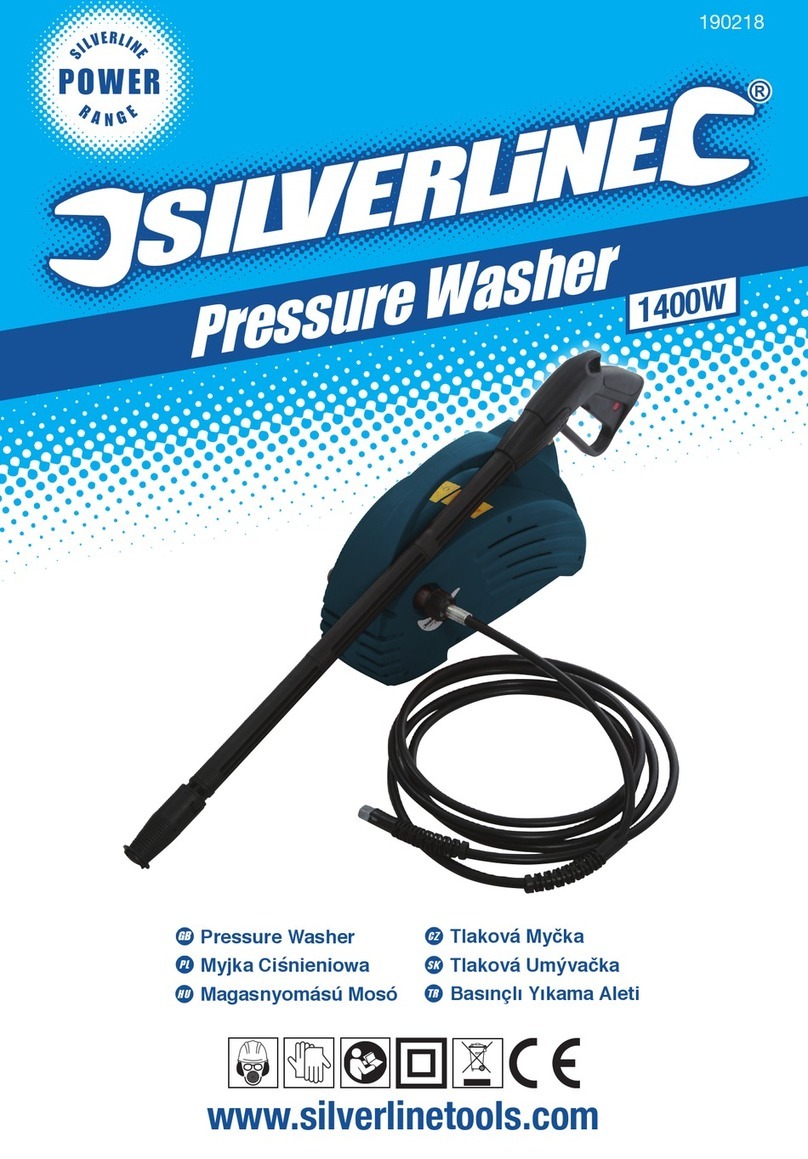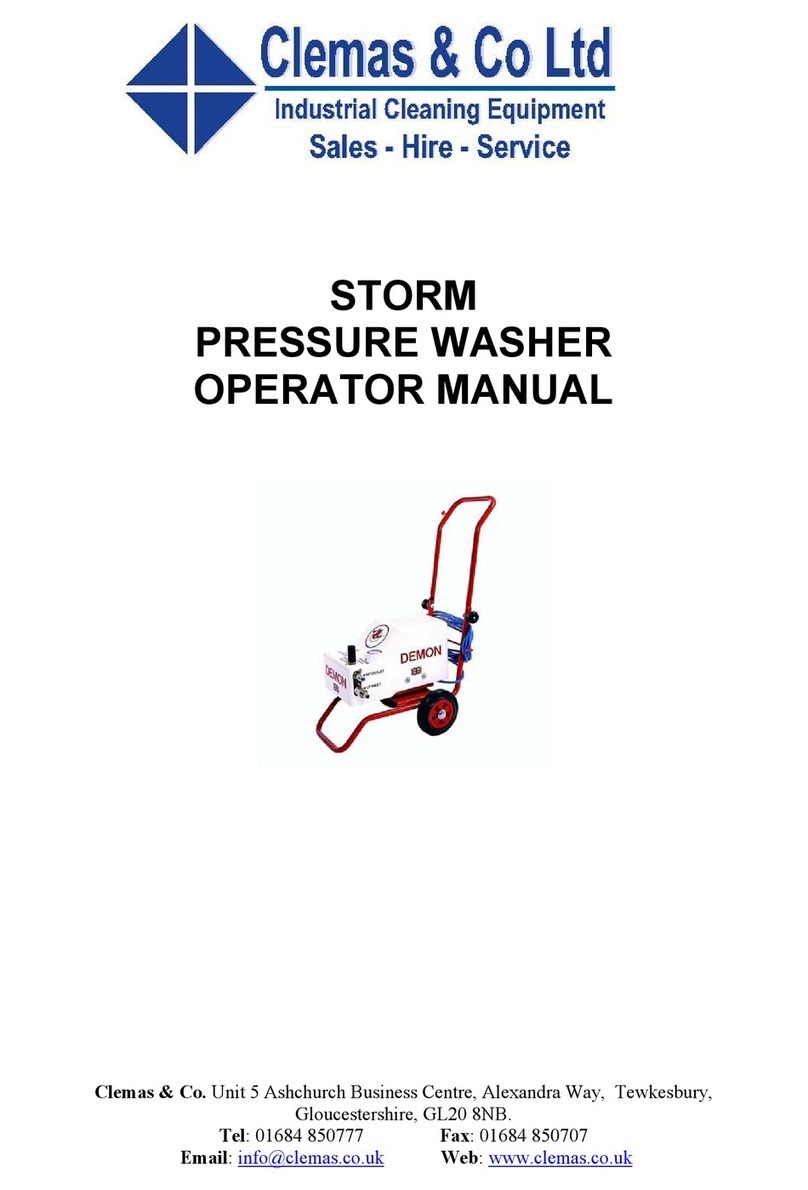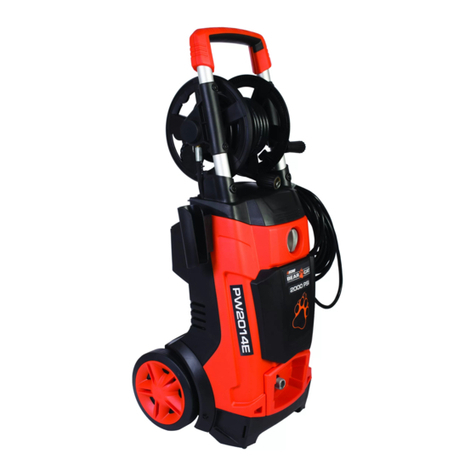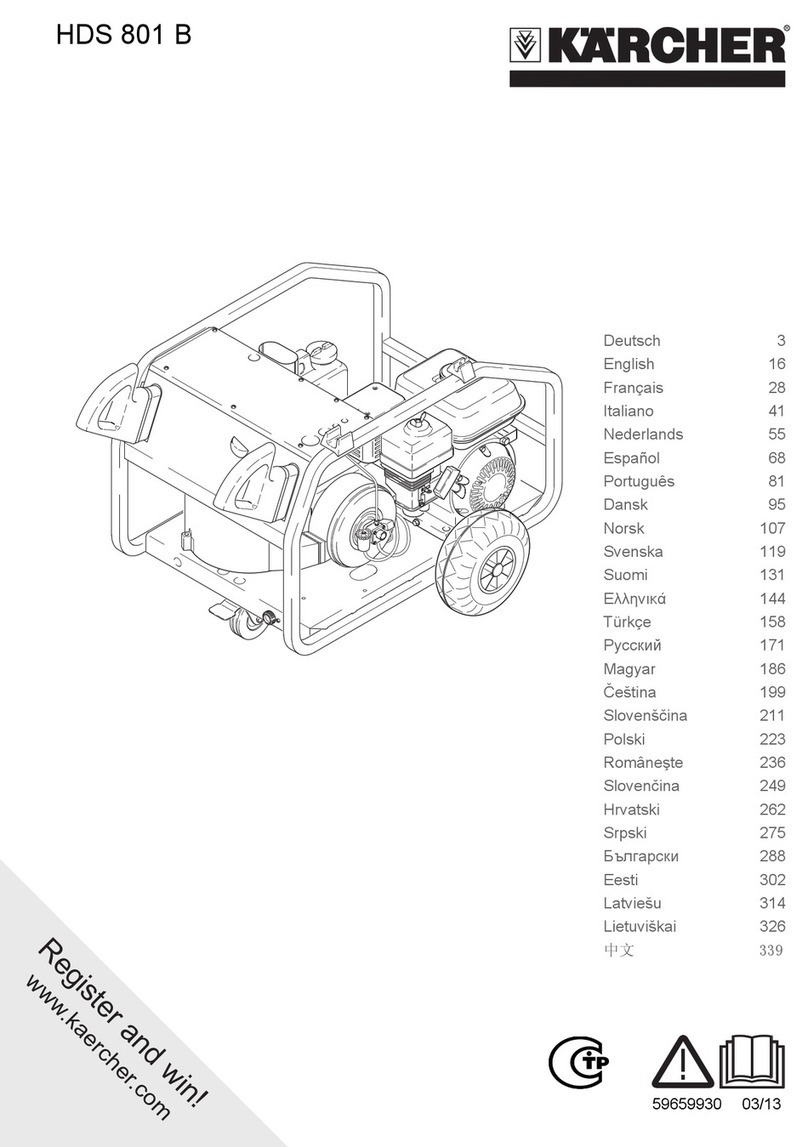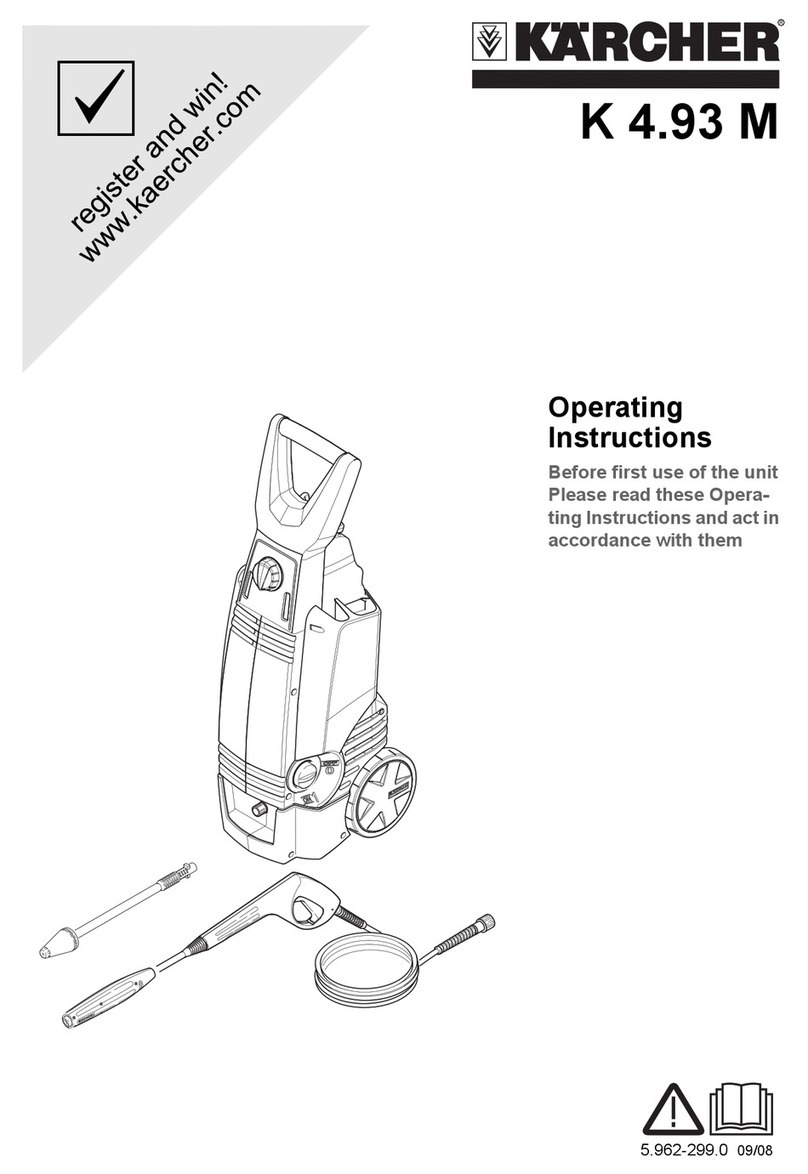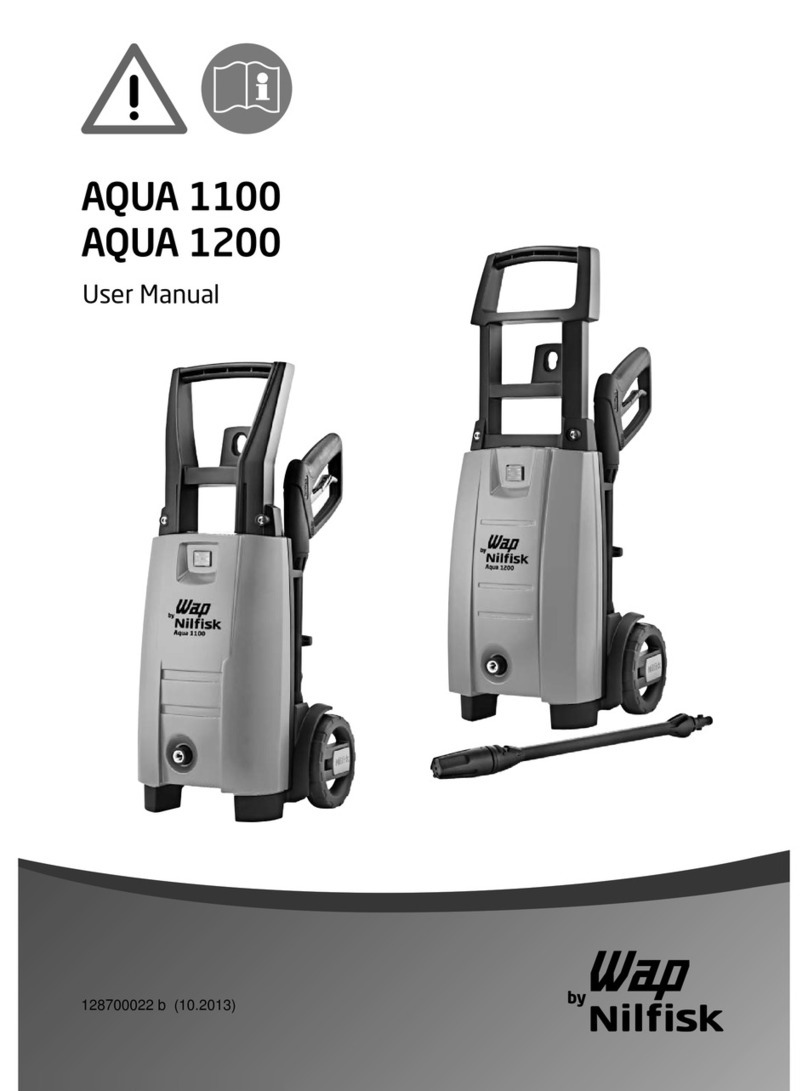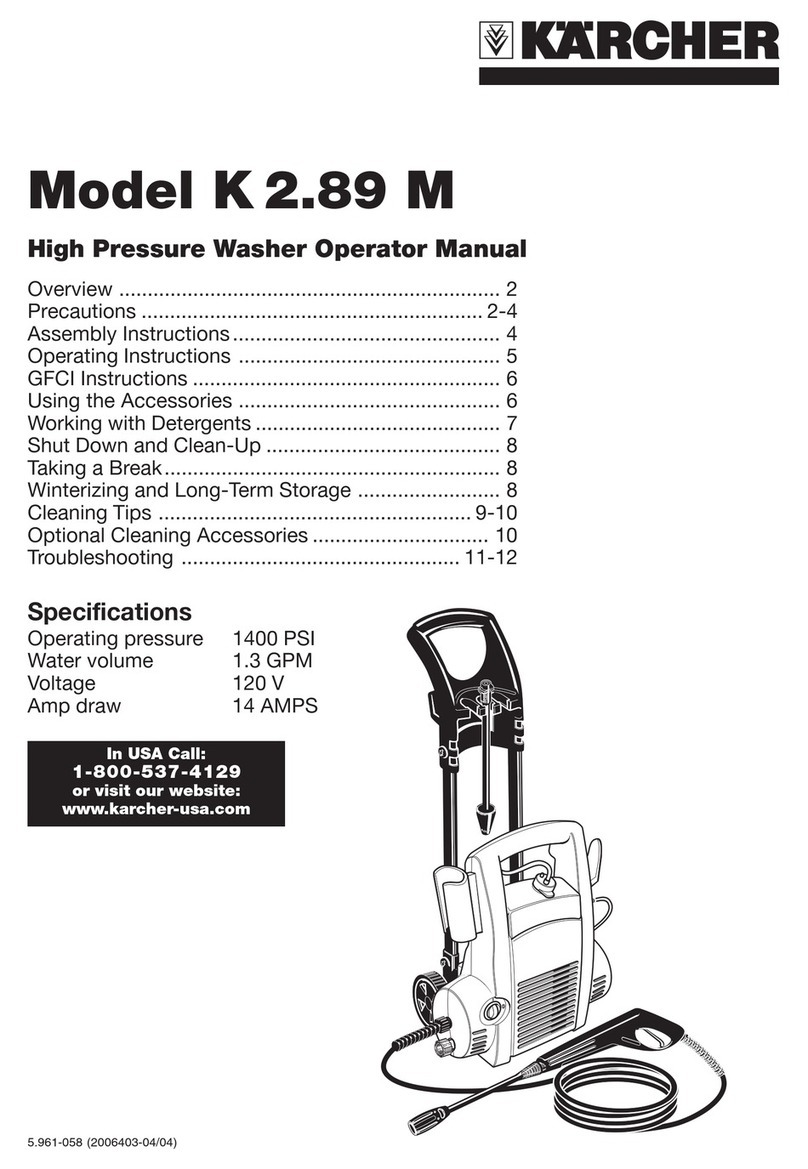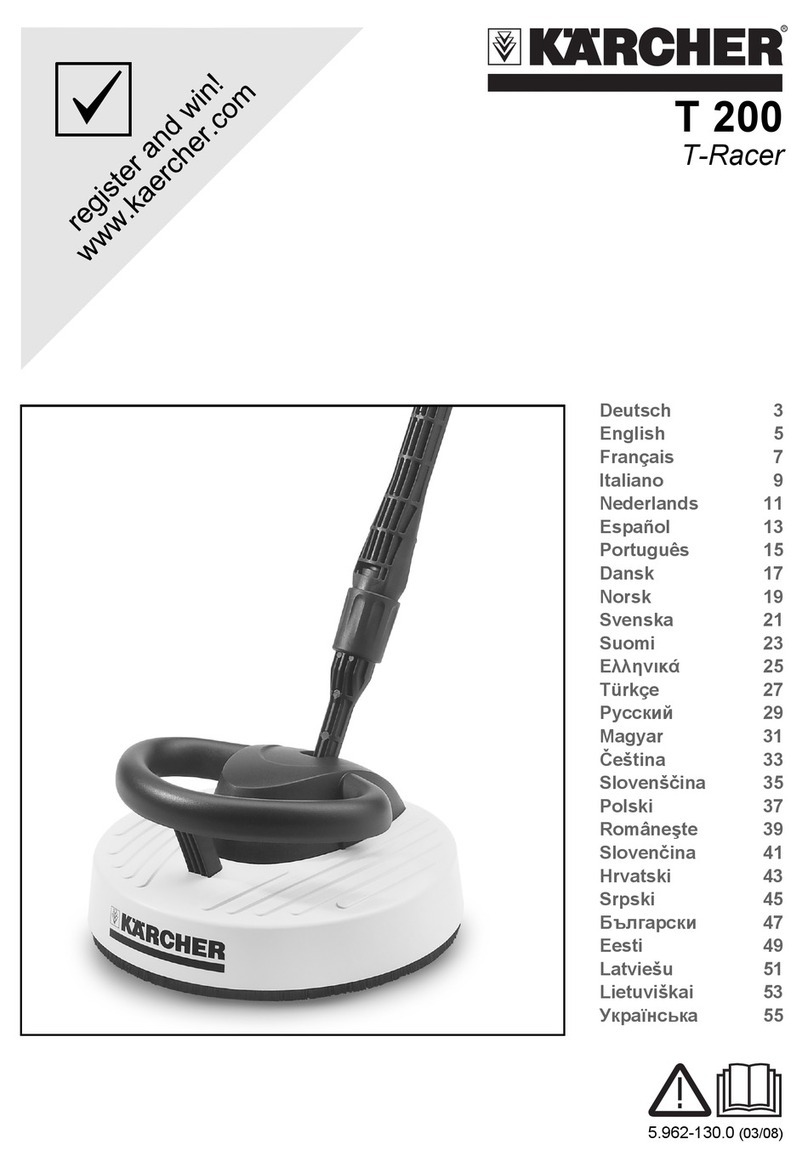Silverline 834832 User manual

Version date: 02.07.19 silverlinetools.com
XXXXXX
FR Nettoyeur haute pression 1 400 W
DE Hochdruckreiniger,1400 W
ES Hidrolimpiadora,1400 W
IT Idropulitrice 1400 W
NL 1400 W hogedrukreiniger
PL Myjkawysokociśnieniowa1400W
1400W Pressure Washer 105bar Max
Register online: silverlinetools.com
3
GUARANTEE
YEAR
ANS DE GARANTIE
JAHRE GARANTIE
AÑOS DE GARANTÍA
ANNI DI GARANZIA
JAAR GARANTIE
LATA GWARANCJI
UK - 834832 / EU - 923460
834832/923460_Manual.indd 1 02/07/2019 12:07

2
834832/923460_Manual.indd 2 02/07/2019 12:07

silverlinetools.com 3
5
4
6
7
123
834832/923460_Manual.indd 3 02/07/2019 12:07

4
23
8 9 10 11 12 13
14
15
17
18
19
16
20
2122
20 21
834832/923460_Manual.indd 4 02/07/2019 12:07

silverlinetools.com 5
AOFF/O ON/I
B
C D
834832/923460_Manual.indd 5 02/07/2019 12:07

6
Fig. I
Fig. II
Fig. IV
Fig. VII
Fig. V
Fig. III
Fig. VI
834832/923460_Manual.indd 6 02/07/2019 12:07

silverlinetools.com 7
English ................8
Français ...............14
Deutsch................20
Español................26
Italiano................32
Nederlands ..........38
Polski ..................44
834832/923460_Manual.indd 7 02/07/2019 12:07

GB
8
Voltage.....................................................230-240V~50Hz
Power...............................................................1400W
Working pressure (Bar) ....................................................70
Max pressure (Bar) . . . . . . . . . . . . . . . . . . . . . . . . . . . . . . . . . . . . . . . . . . . . . . . . . . . . . . .105
Workingowrate...................................................5.5L/min
Maximumowrate .................................................6.8L/min
High pressure hose length ................................................5m
Detergent ratio ......................................................Variable
Inlet water temperature range ..........................................5-50°C
Inlet water pressure (Max)........................................0.4MPa(4bar)
Protection class...........................................................
Ingress protection.......................................................IPX5
Power cable length.......................................................5m
Dimensions (H x L x W) .................................... 460 x 320 x 250mm
Weight.................................................................7kg
Aspartofourongoingproductdevelopment,specicationsofSilverlineproducts
may alter without notice.
Sound & vibration information
According to Machin ery Directive 2006/42/EC:
SoundpressureLPA . . . . . . . . . . . . . . . . . . . . . . . . . . . . . . . . . . . . . . . . . . . . . . . . . . . 81dB(A)
SoundpowerLWA..................................................93.42dB(A)
Uncertainty K............................................................3dB
Weighted vibration ah...............................................<2.5m/s2
According to Outdoor Noise Directive 2000/14/EC:
Guaranteed sound power LWA ..........................................97dB(A)
The sound intensity level for the operator may exceed 85dB(A) and sound
protection measure are necessary.
Technical Abbreviations Key
Specication
WARNING: Always wear ear protection where the sound level exceeds 85dB(A) and limit the time
of exposure if necessary. If sound levels are uncomfortable, even with ear protection, stop using the
toolimmediatelyandchecktheearprotectioniscorrectlyttedandprovidesthecorrectlevelof
sound attenuation for the level of sound produced by your tool.
WARNING: User exposure to tool vibration can result in loss of sense of touch, numbness,tingling
and reduced ability to grip. Long-term exposure can lead to a chronic condition. If necessary,limit
the length of time exposed to vibration and use anti-vibration gloves. Do not operate the tool with
hands below a normal comfortable temperature, as vibration will have a greater effect. Use the
guresprovidedinthespecicationrelatingtovibrationtocalculatethedurationandfrequency
of operating the tool.
Soundandvibrationlevelsinthespecicationaredeterminedaccordingtointernationalstandards.
Theguresrepresentnormaluseforthetoolinnormalworkingconditions.Apoorlymaintained,
incorrectly assembled, or misused tool,may produce increased levels of noise and vibration.
www.osha.europa.eu provides information on sound and vibration levels in the workplace that
may be useful to domestic users who use tools for long periods of time.
Carefully read and understand this manual and any label attached to the tool before use. Keep these
instructions with the product for future reference.Ensure all persons who use this product are fully
acquaintedwiththismanual.
Even when used as prescribed it is not possible to eliminate all residual risk factors.Use with
caution. If you are at all unsure of the correct and safe manner in which to use this tool, do not
attempt to use it.
Description of Symbols
The rating plate on your tool may show symbols.These represent important information about the
product or instructions on its use.
Wear hearing protection.
Wear eye protection.
Wear breathing protection.
Wear head protection.
Wear hand protection.
Read instruction manual.
Caution!
Risk of electrocution!
Class II construction (double insulated for additional protection)
According to the applicable regulations, the appliance must never be used on the
drinking water supply without a system separator
Conforms to relevant legislation and safety standards
Environmental Protection
Waste electrical products should not be disposed of with household waste. Please
recycle where facilities exist. Check with your local authority or retailer for recycling
advice
VVolts
~, AC Alternating current
A, mA Ampere, milli-Amp
Hz Hertz
W, kW Watt, kilowatt
/min or min-1 Operations per minute
Introduction
ThankyouforpurchasingthisSilverlinetool.Thismanualcontainsinformationnecessary
forsafeandeffectiveoperationofthisproduct.Thisproducthasuniquefeaturesand,evenif
you are familiar with similar products, it is necessary to read this manual carefully to ensure
you fully understand the instructions. Ensure all users of the tool read and fully understand
this manual.
Original Instructions
834832/923460_Manual.indd 8 02/07/2019 12:07

1400W Pressure Washer
9
silverlinetools.com
General Safety
WARNING: Read all safety warnings, instructions, illustrations and specications
provided with this appliance. Failure to follow all instructions listed below may result in electric
shock, re and/or serious injury.
Save all warnings and instructions for future reference.
The term “appliance” in the warnings refers to your mains-operated (corded) appliance or battery-
operated (cordless) appliance.
1) Work area safety
a) Keep work area clean and well lit.Cluttered or dark areas invite accidents.
b) Do not operate appliances in explosive atmospheres, such as in the presence of
ammable liquids, gases or dust. Appliances create sparks which may ignite the dust or fumes.
c) Keep children and bystanders away while operating an appliance. Distractions can cause
you to lose control.
2) Electrical safety
a) Appliance plugs must match the outlet. Never modify the plug in any way.Do not use any
adapter plugs with earthed (grounded) appliances. Unmodied plugs and matching outlets
will reduce risk of electric shock.
b) Avoid body contact with earthed or grounded surfaces, such as pipes, radiators, ranges
and refrigerators. There is an increased risk of electric shock if your body is earthed or grounded.
c) Do not abuse the cord. Never use the cord for carrying, pulling or unplugging the
appliance. Keep cord away from heat, oil, sharp edges or moving parts.Damaged or
entangled cords increase the risk of electric shock.
d) When operating an appliance outdoors, use an extension cord suitable for outdoor use.
Use of a cord suitable for outdoor use reduces the risk of electric shock.
e) If operating an appliance in a damp location is unavoidable, use a residual current device
(RCD) protected supply. Use of an RCD reduces the risk of electric shock.
3) Personal safety
a) Stay alert, watch what you are doing and use common sense when operating an
appliance. Do not use an appliance while you are tired or under the inuence of drugs,
alcohol or medication. A moment of inattention while operating appliances may result in
serious personal injury.
b) Use personal protective equipment. Always wear eye protection. Protective equipment
such as a dust mask, non-skid safety shoes,hard hat or hearing protection used for appropriate
conditions will reduce personal injuries.
c) Prevent unintentional starting. Ensure the switch is in the OFF-position before connecting
to source and/or battery pack, picking up or carrying the appliance. Carrying appliances
with your nger on the switch or energising appliances that have the switch ON invites accidents.
d) Remove any adjusting key or wrench before turning the appliance ON. A wrench or a key
left attached to a rotating part of the appliance may result in personal injury.
e) Do not overreach. Keep proper footing and balance at all times. This enables better control
of the appliance in unexpected situations.
f) Do not let familiarity gained from frequent use of appliances allow you to become
complacent and ignore appliance safety principles. A careless action can cause severe injury
within a fraction of a second.
4) Appliance use and care
a) Do not force the appliance. Use the correct appliance for your application.The correct
appliance will do the job better and safer at the rate for which it was designed.
b) Do not use the appliance if the switch does not turn it ON and OFF.Any appliance that
cannot be controlled with the switch is dangerous and must be repaired.
c) Disconnect the plug from the source and/or remove the battery pack,if detachable,
from the appliance before making any adjustments, changing accessories,or storing
appliances. Such preventive safety measures reduce the risk of starting the appliance
accidentally.
d) Store idle appliances out of the reach of children and do not allow persons unfamiliar
with the appliance or these instructions to operate the appliance. Appliances are dangerous
in the hands of untrained users.
e) Maintain appliances and accessories. Check for misalignment or binding of moving parts,
breakage of parts and any other condition that may affect the appliance’s operation.
If damaged, have the appliance repaired before use. Many accidents are caused by poorly
maintained appliances.
f) Use the appliance, accessories and appliance bits,etc. in accordance with these
instructions, taking into account the working conditions and the work to be performed.
Use of the appliance for operations different from those intended could result in a hazardous
situation.
g) Keep handles and grasping surfaces dry,clean and free from oil and grease. Slippery
handles and grasping surfaces do not allow for safe handling and control of the appliance in
unexpected situations.
5) Service
a) Have your appliance serviced by a qualied repair person using only identical
replacement parts. This will ensure that the safety of the appliance is maintained.
Pressure Washer Safety
• Do not operate this appliance in the rain. Keep all electrical connections dry. Do not allow the
machine to become wet. Never allow water to enter ventilation holes
• Alwaysconnectabackowpreventer(alsocalledanon-returnvalve)betweenpressurewasher
andpotablewatermainstopreventabackowcontaminatingyourwatersupply.Alternatively,
connect the pressure washer to a water butt or other stored water supply
• Do not attempt to use this machine in temperatures below 0°C
• Alwaysconnecta‘continuousow’cleanwatersupplytothepressurewasher.Runningthe
pressure washer dry, or with dirty water, will cause permanent damage to the pump
• Never connect the pressure washer to a hot water supply; this will cause the pump to
malfunction and could result in permanent damage
• Ensure that the water supply to the pressure washer is at a constant pressure. If the water supply
is‘shared’byanotherappliance(e.g.washingmachine),ensurethattheotherapplianceis
switched OFF
• The pressure washer should always be used in an upright position
• Be aware that the lance will produce a recoil force when the pressure washer is operated. Hold
the lance securely
• Never direct the water jet at people or animals. The water jet is extremely powerful,and can cause
seriousinjury.Donotdirectthewaterjettowardsthepumpbody,orotherelectricalequipment
• Handle the lance with care, do not allow the nozzle to strike the ground. Do not allow the hoses
to be twisted, crushed,or strained
• Do not attempt to pressure wash any material suspected to contain asbestos
• When using detergents with pressure washers or cleaning oil and grease from surfaces,
take responsibility for any contaminated waste water you may produce.Always consider the
environment and the risk of polluting streams and other watercourses, plus the possibility of
contaminants accumulating in the ground and soil.Try to use detergents sparingly—they are not
always necessary.Contact your local environmental agency for how to deal with such waste water
legally and responsibly
1. Lance bracket / Power Cord Hook
2. ON/OFF Switch
3. Hose Bracket
4. Handle
5. Power Cord
6. High Pressure Water Outlet
7. Water Inlet
8. Nozzle
9. Nozzle Bayonet Connector
10. Lance Extension Socket
11. Lance Extension Bayonet Connector
12. Lance Handle Bayonet Socket
13. Lance High Pressure Hose Connector
14. Lance Handle Grip
15. Trigger Lock
16. Trigger
17. Hose Connector (Pressure Washer Unit)
18. High Pressure Hose
19. Hose Connector (Handle)
20. Cleaning Pin
21. Inlet Hose Connector
22. Lance Detergent Dispenser
23. Cleaning Pin Bracket
Product Familiarisation
834832/923460_Manual.indd 9 02/07/2019 12:07

GB
10
Intended Use
Pressure washer for general,light to medium duty cleaning tasks on vehicles, buildings and other
suitable surfaces, using a jet of cold, pressurised water, with or without detergent.
Unpacking Your Tool
• Carefully unpack and inspect your product. Fully familiarise yourself with all its features and
functions
• Ensure that all parts of the product are present and in good condition. If any parts are missing or
damaged, have such parts replaced before attempting to use this product
Before Use
• Always check all parts and attachments are secure, and that hoses are not kinked or obstructed
• Alwayswearappropriatepersonalprotectiveequipmentforthejobathand.Useofthisappliance
requiressafetygogglesandwaterproofclothing
• Always use an RCD when connecting a pressure washer to the mains with a tripping current of no
more than 30mA, and a delay in operating of no more than 30ms
• Make sure mains connection points are out of reach of the pressure washer water spray and any
water that may collect on surrounding surfaces
• Onlyuseamainsextensioncablesuitableforoutdooruseandcapableofcarryingtherequired
current for this product.The cable must be protected against water ingress and maintain water-
tight connections where it connects to the pressure washer
• This product must be earthed and any extension cables used must have an earth connection
• Alwaysusethepressurewasherverticallyandmakesureitisusedonaat,levelsurface
Assembly
• Do not connect the pressure washer to the water or electrical supply until fully assembled and
ready for use
• Remove all packaging materials from the product
• Attach Lance Bracket / Power Cord Hook (1) to main assembly sliding it down until it clicks
securely into place (Fig.VI)
Lance
• To assemble the Lance, insert Lance Extension Bayonet Connector (11) into Lance Handle
BayonetSocket(12)thenrotateandreleasesothebayonetconnectorislockedinthegrooveof
the bayonet socket (Fig.I)
• AttachtheNozzleBayonetConnector(9)toLanceExtensionSocket(10)byrepeatingtheabove
process (Fig. I)
Notes:
• IfusingtheLanceDetergentDispenser(22)ttotheLanceExtensionSocket(10)insteadofthe
Nozzle Bayonet Connector (9) (Fig.I)
• DonotattempttottheNozzleBayonetConnector(9)orLanceDetergentDispenser(22)directly
intotheLanceHandleBayonetSocket(12).Thettingsareadifferentsize
High pressure hose
1. RemovetheplasticcapfromtheHoseConnector(Handle)(19)iftted(Fig.II)
2. Carefully cut and remove cable ties around the hose (making sure not to damage the hose
surface), then uncoil hose
3. Attach the Hose Connector (Handle) (19) to the Lance High Pressure Hose Connector (13) (Fig.
IV),thenscrewthettingstogetheruntiltight
4. Remove the plastic cap from the High Pressure Water Outlet (6) (Fig. II)
5. AttachtheHoseConnector(17)totheHighPressureWaterOutlet(6),andscrewthettings
together until tight (Fig.VII)
WARNING: If the high pressure hose is damaged it can burst and cause injury. A damaged hose
must be replaced, not repaired.Inspect regularly and prevent the hose from coming into contact
with sharp objects or rough surfaces.
Connecting to water supply
WARNING: When connecting a pressure washer to a normal domestic water supply, ensure a
non-returnvalveisttedtothehose(alsocalledbackowpreventer).Thiswillpreventthepressure
washercontaminatingthewatersupplyifthereisabackow.
1. Remove the plastic cap from the Water Inlet (7) (Fig.II)
2. Checkthelterinsidethewaterinletisclearofdebrisoranyothermaterial.Overtimedebris
maybuildupandthelterwillneedtobecheckedregularlyandanydebrisbuild-upremoved
3. Fit the Inlet Hose Connector (21) to Water Inlet (7) and tighten by hand only (Fig.III)
4. Connect a hose from the water supply to the Inlet Hose Connector (21)
Notes:
• Thespecicationlistssuitablewaterinletpressures.Donotexceedthemaximumwaterpressure
statedinthespecication
• If you do not know or are unable to measure the water pressure, keep the pressure low to prevent
damage to the pressure washer.Aim to set the pressure at mid-point between the lowest and
highest water pressure accepted by the pressure washer. If preferred, a third party water pressure
gauge is available that connects directly to the tap.This will allow the water pressure to be set
more accurately
• Do not connect to a hot water supply.This will prevent the pump from cooling and may damage
the seals over time
• It is important that a good water connection is maintained while operating a pressure washer, as
the pump will be damaged if run without water. Make sure the connections are secure before
turning ON the pressure washer
Connecting to other water sources
Note: The pump featured in this pressure washer features a self-priming feature that allows use of
other water sources typically a water butt or other container of captured rain water or similar.
• Ensurethewatersupplyiscleanandlteredbeforeenteringthepressurewasher.Ensurethereis
no sediment
• For water butts, where the output is at the bottom,gravity will provide some pressure to assist the
pressure washer
The hose to the water supply should not exceed 3m in length and the diameter should not be less
than 19mm or ¾”
Operation
Switching ON
IMPORTANT: Always open the water supply tap before switching ON the pressure washer to protect
the pump from damage
1. SettheTriggerLock(15)topreventtheTrigger(16)beingpressed(ImageD)
2. ConnectthepressurewashertothemainssupplyandswitchtheON/OFFSwitch(2)ON(Image
A).The pump will operate immediately to build up pressure automatically
Note: The water pressure will restore automatically each time the trigger is pressed.
IMPORTANT: Ensure all the air is bled from the hoses and lance before using the pressure washer.
DisabletheTriggerLock(15)andsqueezeandholdthetriggeruntilwaterissprayedinasteady
stream.Thismaytakeupto2minutesorpossiblylongeronrstuse(ImageD)
Using your pressure washer
WARNING: Do not run the pressure washer continuously for longer than 1 minute.Use more
frequentshortersweepingbursts.
1. Tospraywater,squeezetheTrigger(16).Makesureyouareholdingthelancesecurelyasthere
will be a small recoil action when started. The Trigger (16) allows for some adjustment of spray
power,depending on how far the trigger is depressed
2. To disable the Trigger (16), use the Trigger Lock (15) when necessary (Image D)
Notes:
• The Lance Nozzle (8) can be adjusted between a wide fan pattern (60° spray angle), and a strong
narrow jet (0°) (Image C). It is advisable to start with the nozzle turned clockwise (fan pattern),
and experiment with narrower patterns,and different spray distances, until the correct strength is
achieved. Release the trigger when changing setting
• If you are unsure of the durability of the surface that is being cleaned, avoid using the narrow jet
setting and start at a longer distance to the surface
• Itisrecommendedthelanceisheldatanangleof45˚tothesurfacebeingcleaned.Thiswillgive
maximum control, and most effective cleaning
WARNING:Alwaystest-cleananinconspicuousarearsttocheckthatthecleaningprocessor
detergent will not damage the surface being cleaned, particularly mortar between bricks or patio
slabs, which can be easily removed with a water jet
WARNING: Do not press the trigger for longer than 1 minute as the pump may become excessively
hot.Alwaysallowsomeofftimeasyouworkanddon’twastewateronsurfacesthatdonotrequire
cleaning.Thismachineisttedwithanautomaticthermalcut-outandifthepumpoverheatsitwill
stop.The system will automatically reset after cooling for a few minutes.Always try to work in a way
that avoids the thermal cut-out from operating by giving the pump time to cool when possible
834832/923460_Manual.indd 10 02/07/2019 12:07

1400W Pressure Washer
11
silverlinetools.com
Using the detergent dispenser
1. When changing accessories, switch OFF the pressure washer,turn OFF the water supply and
squeezethetriggertoreleasepressure(ImageA)
2. RemovetheNozzle(8)iftted
3. FittheLanceDetergentDispenser(22)totheLanceExtensionSocket(10)
4. Removethedispenserbottleandllwithsuitablepressurewasherdetergentorcarshampoo,
thenre-t(Fig.V)
5. Usethepressurewasheraspernormaloperationtodispensefoamasrequired.TheTrigger(16)
will control how much foam is dispensed.There are no adjustments on the detergent dispenser
6. Use all detergent, ensuring water runs clear and is foam-free at end of use
Notes:
• Atypicalpatternofuseforusingdetergentfoamwouldbetorstcleanthesurfacewithwaterto
removelightsurfacedeposits,thenapplydetergentfoamandnally,rinseoffwithcleanwater
• Detergentfoamrequiresafewminutestoworkwhenapplied.Formaximumcleaning,leave2-5
minutes between applying the foam and removing with clean water - this is an ideal opportunity
to brush/scrub the surface where most dirt has collected. Do not allow foam to dry on the surface,
for instance, on a hot day, when there may be limited time between dispensing foam and rinsing
off, depending on the surface
• Do not use detergents which are not designed for use with pressure washers. They may contain
chemicals that could damage seals
• The detergent dispenser is only suitable for detergents with a viscosity close to that of water.
Ifnecessary,dilutedetergentbeforellingthedetergentdispenser.Thispressurewasher
has an approximate detergent ratio of 1/19th or 95% water to 5% detergent in use. Read the
instructions provided with the detergent thoroughly - especially if concentrated. Diluting to
thedetergentmanufacturer’srecommendationswillensureeffectivecleaningwithoutusing
excessive detergent
Switching OFF
Whenyouhavenishedusingthemachine,alwayscarryoutthefollowingsteps:
1. SwitchOFFthemachineanddisconnectfromthemainssupply(ImageA)
2. Turn OFF the water supply
3. Squeezethetriggerandallowallresidualwaterpressuretobleed
4. Disconnect the water supply
5. Drain all water from the machine and hoses, and store in a dry place
WARNING: Do not switch OFF the water supply before turning OFF the pump as the pump must
not be run without water.
Accessories
ArangeofaccessoriesisavailablefromyourSilverlinestockisttoenhancethefunctionalityofyour
pressurewasher,includingbrushesandreplacement,orhigherspecicationparts.
Maintenance
Cleaning
• Keep your machine clean at all times
• Always allow all water to drain from the pump before storing
• The Nozzle (8) Lance Detergent Dispenser (22) and Lance Extension (10) may get dirty or blocked
over time, which will effect operation.Clean using the Cleaning Pin (20) supplied (Image B).
• The Cleaning Pin (20) can be stored in the Cleaning Pin Bracket (23)
• AgardenhosecanalsobeusedtocleantheLancecomponentsbyback-ushingwaterthrough.
Combininguseofthepinandback-ushingshouldallowthecomponentstobethoroughly
cleaned.Thefrequencyofcarryingoutthistaskwilldependonthewaterqualityinyourarea.
Hardwaterareasrequiremorefrequentcleaning
• RegularlychecktheInletHoseConnectorltertomakesureitisclear.Thisltermustbechecked
regularly to ensure it is clear from debris and other materials.Remove the Inlet Hose Connector
(21)toaccessthelter
Brushes
• Over time the carbon brushes inside the motor may become worn
• Excessively worn brushes may cause loss of power, intermittent failure,or visible sparking
• Ifyoususpectthatthebrushesmaybeworn,havethemreplacedatanauthorisedSilverline
service centre
Storage
• Alwaysstorethismachineinadryplacethatwillnotfallbelow0˚C
• Ensure all inlets / outlets are capped if not connected to prevent foreign objects entering the
appliance when not in use
Disposal
Always adhere to national regulations when disposing of appliances that are no longer functional
and are not viable for repair.
• Donotdisposeofappliances,orotherwasteelectricalandelectronicequipment(WEEE),with
household waste
• Contact your local waste disposal authority for information on the correct way to dispose of
appliances
834832/923460_Manual.indd 11 02/07/2019 12:07

GB
12
Problem Possible cause Solution
No detergent suction Blockage in detergent bottle tube Clean with warm water
Smoke Overload or damaged motor DONOTUSE.ContactdealerorauthorisedSilverlineservicecentreimmediately
Pressurewasherdoesn’tstart
Pressurised Squeezetriggerongunbeforestarting
Mains plug not fully inserted or mains socket is switched
OFF Check and correct issues
RCD has operated or not been reset Reset RCD
Plug fuse has blown Replace fuse and contact dealer if it blows again immediately
Thermal safety switch has operated SwitchOFFandallowpressurewashermotortocoolbeforestarting
Poor water spray pressure
Waterinletlterisclogged Cleanlter
Water hose connection is leaking or allowing air to enter Check water hose connection
Pressure washer valves or seals are worn or damaged ContactdealerorauthorisedSilverlineservicecentreimmediately
Clogged nozzle See‘Maintenance’forcleaningprocedure
Motor stops suddenly Thermal safety switch has operated SwitchOFFandallowtocoolbeforerestarting
Water leaking from pump Sealswornout ContactdealerorauthorisedSilverlineservicecentreimmediately
Troubleshooting
834832/923460_Manual.indd 12 02/07/2019 12:07

1400W Pressure Washer
13
silverlinetools.com
Terms & Conditions
Silverline Tools Guarantee
This Silverline product comes with a 3 year
guarantee
Registerthisproductatwww.silverlinetools.comwithin30daysofpurchaseinordertoqualify
for the 3 year guarantee. Guarantee period begins according to the date of purchase on your
sales receipt.
Registering your purchase
Registration is made at silverlinetools.com by selecting the Guarantee Registration button. You
will need to enter:-
• Your personal details
• Details of the product and purchase information
OncethisinformationisenteredyourguaranteecerticatewillbecreatedinPDFformatforyou
to print out and keep with your purchase.
Guarantee period becomes effective from the date of retail purchase as detailed on your sales
receipt.
PLEASE KEEP YOUR SALES RECEIPT
If this product develops a fault within 30 days of purchase, return it to the stockist where it
was purchased, with your receipt,stating details of the fault. You will receive a replacement
or refund.
If this product develops a fault after the 30 day period, return it to:
Silverline Tools Service Centre
PO Box 2988
Yeovil
BA21 1WU, UK
The guarantee claim must be submitted during the guarantee period.
You must provide the original sales receipt indicating the purchase date, your name, address
and place of purchase before any work can be
carried out.
Youmustprovideprecisedetailsofthefaultrequiringcorrection.
ClaimsmadewithintheguaranteeperiodwillbeveriedbySilverlineToolstoestablishifthe
decienciesarerelatedtomaterialormanufacturingoftheproduct.
Carriage will not be refunded.Items for return must be in a suitably clean and safe state for
repair,and should be packaged carefully to prevent damage or injury during transportation. We
may reject unsuitable or
unsafe deliveries.
AllworkwillbecarriedoutbySilverlineToolsoritsauthorized
repair agents.
The repair or replacement of the product will not extend the period
of guarantee
Defects recognised by us as being covered by the guarantee shall be corrected by means of
repair of the tool, free of charge (excluding carriage charges) or by replacement with a tool in
perfect working order.
Retained tools, or parts,for which a replacement has been issued, will become the property of
SilverlineTools.
Therepairorreplacementofyourproductunderguaranteeprovidesbenetswhichare
additional to and do not affect your statutory rights as a consumer.
What is covered:
Therepairoftheproduct,ifitcanbeveriedtothesatisfactionofSilverlineToolsthatthe
deciencieswereduetofaultymaterialsorworkmanshipwithintheguaranteeperiod.
Ifanypartisnolongeravailableoroutofmanufacture,SilverlineToolswillreplaceitwitha
functional replacement part.
Use of this product in the EU.
What is not covered:
SilverlineToolsdoesnotguaranteerepairsrequiredasaresultof:
Normal wear and tear caused by use in accordance with the operating instructions eg blades,
brushes, belts, bulbs, batteries etc.
The replacement of any provided accessories drill bits, blades,sanding sheets, cutting discs and
other related items.
Accidental damage, faults caused by negligent use or care,misuse, neglect, careless operation
or handling of the product.
Use of the product for anything other than normal domestic purposes.
Changeormodicationoftheproductinanyway.
UseofpartsandaccessorieswhicharenotgenuineSilverlineToolscomponents.
Faultyinstallation(exceptinstalledbySilverlineTools).
RepairsoralterationscarriedoutbypartiesotherthanSilverlineToolsoritsauthorizedrepair
agents.
Claims other than the right to correction of faults on the tool named in these guarantee
conditions are not covered by the guarantee.
834832/923460_Manual.indd 13 02/07/2019 12:07

FR
14
AVERTISSEMENT : Porteztoujoursdesprotectionsauditiveslorsqueleniveaud’intensitéest
supérieurà85dB(A)etlimitezletempsd’expositionsinécessaire.Sil’intensitésonoredevient
inconfortable,mêmeaveclesprotections,arrêtezimmédiatementd’utiliserl’appareil,vériezque
lesprotectionssontbienenplacesetadaptésavecleniveausonoreproduitparl’appareil.
AVERTISSEMENT : L’expositiondel’utilisateurauxvibrationspeutengendrerunepertedutoucher,
desengourdissements,despicotementsetainsiréduirelacapacitédepréhension.Delongues
expositionspeuventégalementprovoquercessymptômesdefaçonchronique.Sinécessaire,
limitezletempsd’expositionauxvibrationsetportezdesgantsanti-vibrations.N’utilisezpascet
appareillorsquelatempératuredevosmainsestendessousdestempératuresnormales,carl’effet
vibratoireenestaccentué.Référez-vousauxchiffresindiquésdanslescaractéristiquestechniques
descaractéristiquesrelatifsauxvibrationspourcalculerletempsetlafréquenced’utilisationde
l’appareil.
Lesniveauxsonoresetvibratoiresindiquésdanslasection«Caractéristiquestechniques»
duprésentmanuelsontdéterminésenfonctiondenormesinternationales.Cesdonnées
correspondentàunusagenormaldel’appareil,etcedansdesconditionsdetravailnormales.
Unappareilmalentretenu,malassembléoumalutilisépeutaugmenterlesniveauxsonoreset
vibratoires. Le site www.osha.europa.eu offre de plus amples informations sur les niveaux sonores
etvibratoiressurlelieudetravail,celles-cipourrontêtreutilesàtoutparticulierutilisantdesoutils
électriquespendantdespériodesprolongées.
Abréviations pour les termes
techniques
Description des symboles
Laplaquesignalétiquegurantsurvotreoutilpeutprésenterdessymboles.Cessymboles
constituent des informations importantes relatives au produit ou des instructions concernant son
utilisation.
Port de protection auditive
Portdelunettesdesécurité
Portdemasquerespiratoire
Portdecasque
Port de gants
Lirelemanueld’instructions
Attention !
Risqued’électrocution!
ConstructiondeclasseII(Doubleisolationpouruneprotectionsupplémentaire)
Enconformitéaveclesréglementationsenvigueurpertinentes,l’appareilne
doitjamaisêtreraccordéàunesourced’approvisionnementeneaupotablesans
séparateur!
Conformeauxréglementationsetauxnormesdesécuritépertinentes.
Protectiondel’environnement
Lesappareilsélectriquesusagésnedoiventpasêtrejetésaveclesordures
ménagères.Veuillezlesrecyclerdanslescentresprévusàceteffet.Pourdeplus
amplesinformations,veuillezcontactervotremunicipalitéoupointdevente.
Tension : . . . . . . . . . . . . . . . . . . . . . . . . . . . . . . . . . . . . . . . . . . . . . . . . . . . 230-240 V~50 Hz
Puissance : ......................................................... 1 400 W
Pression de service :....................................................70 bar
Pression maximale : ..................................................105 bar
Débitdeservice ....................................................5,5 L/min
Débitmaximum:……………………………………………………....6,8L/min
Longueur du tuyau haute pression : ........................................5 m
Tauxdedétergent:....................................................Variable
Plagedetempératuredel’eauàl’entrée:.................................5 - 50°C
Pressiondel’eauàl’entrée: .....................................0,4 MPa ( 4 bar)
Classe de protection :......................................................
Indice de protection : ....................................................IPX5
Longueurducâbled’alimentation:.........................................5 m
Dimensions (L x l x H) : .................................... 460 x 320 x 250 mm
Poids : .................................................................7 kg
Dufaitdel’évolutionconstantedenosproduits,lescaractéristiquesdesproduitsSilverline
peuventchangersansnoticationpréalable.
Informationsrelativesauniveaud’intensitésonoreetvibratoire
Conformémentàladirectivesurlesmachines2006/42/CE
Pressionacoustique(LPA): .............................................81 dB(A)
Puissanceacoustique(LWA):.........................................93,42 dB(A)
Incertitude :..........................................................3 dB(A)
Vibrationpondéréeah: ..............................................<2,5m/s²
Conformémentàladirectivesurlesémissionssonoresdansl’environnementdes ...
matérielsdestinésàêtreutilisésàl’extérieurdesbâtiments2000/14/CE
PuissanceacoustiquegarantieLWA :.....................................97 dB(A)
L’intensitésonorepeutdépasser85dB(A)etilestnécessairequel’utilisateurportedes
protections auditives.
Introduction
Nousvousremercionsd’avoirchoisicetéquipementSilverline.Cesinstructionscontiennentles
informationsnécessairespourvousengarantirunfonctionnementefcaceetentoutesécurité.
Veuillez lire attentivement ce manuel pour vous assurer de tirer pleinement avantage des
caractéristiquesuniquesdevotrenouveléquipement.
Gardezcemanuelàportéedemainetassurez-vousquetouslesutilisateursl’aientluetbien
comprisavanttouteutilisation.Conservez-lepourtouteréférenceultérieure.
Traduction des instructions originales
Caractéristiques techniques
VVolt
~, AC Courant alternatif
A, mA Ampère,Milliampère
Hz Hertz
W, kW Watt, kilowatt
/min or min-1 (opérations)parminute
834832/923460_Manual.indd 14 02/07/2019 12:07

Nettoyeur haute pression 1 400 W
15
silverlinetools.com
Veuillezlireattentivementetassimilerlesinformationscontenuesdansleprésentmanuelainsi
quetoutementionéventuellementapposéesuruneétiquetteprésentesurvotreappareilmême
avantd’entreprendred’utilisercetappareil.Veuillezconservercesinstructionsetconsignesde
sécuritépourréférenceultérieure.Assurez-vousquetouteslespersonnesquiutiliserontceproduit
aientprispleinementconnaissancedesprésentesinstructions.
Mêmes’ilestutiliséselonl’usageconformeetdanslerespectdesprésentesconsignesdesécurité,
ilestimpossibled’éliminertoutfacteurderisque.Àutiliserenprenantuneextrêmeprécaution.
Sivousavezunquelconquedoutesurlamanièred’utilisercetappareilentoutesécurité,
n’entreprenezpasdevousenservir.
Consignes de sécurité générales
relatives à l’utilisation d’appareils
électriques
AVERTISSEMENT: Veuillez lire toutes les consignes de sécurité et toutes les instructions
dispensées dans le présent manuel. Le non-respect des instructions et consignes de sécurité peut
entraîner un risque de décharge électrique, d’incendie et/ou se traduire par des blessures graves.
Veuillez conserver ces instructions et consignes de sécurité pour référence ultérieure.
L’expression« appareil électrique »employée dans les présentes consignes recouvre aussi bien les
appareils laires à brancher sur secteur que les appareils sans ls fonctionnant avec batterie.
1) Sécurité sur la zone de travail
a. Maintenir une zone de travail propre et bien éclairée. Des zones encombrées et mal éclairées
sont sources d’accidents.
b. Ne pas utiliser d’appareils électriques dans des environnements explosifs, tels qu’à
proximité de liquides, de gaz ou de poussières inammables. Les appareils électriques
produisent des étincelles susceptibles d’enammer la poussière ou les vapeurs présentes.
c. Éloigner les enfants et toute personne se trouvant à proximité pendant l’utilisation d’un
appareil électrique. Ceux-ci pourraient vous distraire et vous faire perdre la maîtrise de l’appareil.
2) Sécurité électrique
a. Les prises des appareils électriques doivent correspondre aux prises du secteur. Ne
modiez jamais la prise en aucune façon. N’utilisez jamais d’adaptateur avec les appareils
électriques mis à la terre. Des prises non modiées, adaptées aux boîtiers de prise de courant,
réduiront les risques de décharge électrique.
b. Éviter le contact corporel avec les surfaces mises à la terre telles que tuyaux, radiateurs,
cuisinières et réfrigérateurs. Le risque de décharge électrique est plus important si votre corps
est mis à la terre.
c. Ne pas maltraiter le cordon électrique. N’utilisez jamais le cordon électrique pour porter,
tirer ou débrancher l’appareil électrique. Conservez le cordon électrique à l’écart de
la chaleur, de l’essence, de bords tranchants ou de pièces en mouvement. Un cordon
électrique endommagé ou entortillé accroît le risque de décharge électrique.
d. Au cas où l’appareil électroportatif serait utilisé à l’extérieur, servez-vous d’une rallonge
appropriée à une utilisation en extérieur. Cela réduit le risque de décharge électrique.
e. Si une utilisation de l’appareil dans un environnement humide ne peut être évitée, utilisez
une alimentation protégée par un disjoncteur différentiel.L’utilisation d’un disjoncteur
différentiel réduit le risque de décharge électrique.
3) Sécurité des personnes
a. Rester vigilant et faire preuve de bon sens lors de la manipulation de l’appareil. Ne pas
utiliser d’appareil électrique en état de fatigue ou sous l’inuence de drogues, d’alcool ou
de médicaments. Un moment d’inattention pendant l’utilisation d’un appareil électrique peut se
traduire par des blessures graves.
b. Porter des équipements de protection. Porter toujours des lunettes de protection. Le port
d’équipements de protection tels que des masques à poussières, des chaussures de sécurité
antidérapantes, un casque de sécurité ou des protections antibruit, selon le travail à effectuer,
réduira le risque de blessures aux personnes.
c. Éviter tout démarrage accidentel. S’assurer que l’interrupteur marche-arrêt soit en position
d’arrêt (Off) avant de brancher l’appareil sur l’alimentation secteur. Porter un appareil
électrique tout en maintenant le doigt posé sur l’interrupteur ou brancher un appareil électrique
dont l’interrupteur est sur la position de marche (On) est source d’accidents.
d. Enlever toute clé ou tout instrument de réglage avant de mettre l’appareil électrique en
marche. Une clé ou un instrument de réglage resté xé à un élément en rotation de l’appareil
électrique peut entraîner des blessures physiques.
e. Ne pas essayer d’atteindre une zone hors de portée. Se tenir toujours en position stable et
conserver l’équilibre. Cela permet de mieux contrôler l’appareil électrique dans des situations
inattendues.
f. Ne relâchez pas votre vigilance sous prétexte qu’un usage fréquent vous donne
l’impression de vous sentir sufsamment en conance et familier avec l’appareil et son
utilisation. Les consignes de sécurité ne doivent en aucun cas être ignorées. Une action
inconsidérée qui ne durerait ne serait-ce qu’une fraction de seconde pourrait entraîner un
accident impliquant de graves blessures.
4) Utilisation et entretien d’appareils électriques
a. Ne pas surcharger l’appareil électrique. Utiliser l’appareil électrique approprié au travail
à effectuer. Un appareil électrique adapté et employé au rythme pour lequel il a été conçu
permettra de réaliser un travail de meilleure qualité et dans de meilleures conditions de sécurité.
b. Ne pas utiliser un appareil électrique dont l’interrupteur marche-arrêt est hors service.
Tout appareil électrique dont la commande ne s’effectue plus par l’interrupteur marche-arrêt est
dangereux et doit être réparé.
c. Débrancher l’appareil électrique avant d’effectuer tout réglage, changement d’accessoire
ou avant de le ranger.De telles mesures préventives réduiront les risques de démarrage
accidentel.
d. Ranger les appareils électriques inutilisés hors de portée des enfants et ne pas permettre
l’utilisation de ces appareils aux personnes novices ou n’ayant pas connaissance de
ces instructions. Les appareils électriques sont dangereux dans les mains d’utilisateurs
inexpérimentés.
e. Veiller à l’entretien des appareils électriques. Vérier que les éléments rotatifs soient
bien alignés et non grippés. S’assurer de l’absence de pièces cassées ou endommagées
susceptibles de nuire au bon fonctionnement de l'appareil. Si l’appareil électrique est
endommagé, le faire réparer avant toute utilisation.De nombreux accidents sont causés par
l’utilisation d’appareils électriques mal entretenus.
f. Utiliser l’appareil électrique, les accessoires et les appareils à monter, etc., conformément
à ces instructions et selon l’utilisation prévue pour le type d’appareil donné, en tenant
compte des conditions de travail et de la tâche à réaliser. Toute utilisation de cet appareil
électrique autre que celle pour laquelle il a été conçu peut entraîner des situations à risque et
entraînerait une annulation de sa garantie.
g. Veillez à ce que les poignées et toute surface de préhension de l’appareil soient toujours
propres, sèches et exemptes d’huile et de graisse. Une poignée ou une surface de préhension
rendue glissante ne consentirait pas à l’utilisateur de conserver une parfaite maîtrise de son
appareil en toutes circonstances.
5) Entretien
a. Ne faire réparer l’appareil électrique que par un réparateur qualié utilisant uniquement
des pièces de rechange identiques. Cela permettra d’assurer la sécurité continue de cet
appareil électrique.
Consignes de sécurité relatives aux
nettoyeurs haute pression
•N’utilisezpascetappareilsouslapluie.Assurez-vousquelesraccordementsélectriquessoient
secs.Veillezàcequel’appareilnesoitjamaishumide.Nelaissezjamaisl’eaupénétrerparles
oricesdeventilation.
• Branchez toujours une valve anti-retour entre le tuyau du nettoyeur haute pression et le robinet
pouréviterunecontaminationdel’eau.
•Netentezpasd’utilisercetappareilàunetempératureinférieureà0°C.
•L’appareildoittoujoursêtreraccordéàunesourced’approvisionnementeneaupropreet
courante(robinet).Touteopérationentrepriseàsecouavecdel’eausalepourraitoccasionnerdes
dommagesirrémédiablessurlapompe.
•Lenettoyeurhautepressionnedoitjamaisêtreraccordéàunesourced’approvisionnementen
eauchaude.Celapourraitprovoquerundysfonctionnementouunendommagementpermanent
del’appareil.
•Assurez-vousquel’approvisionnementeneaudunettoyeursoitàpressionconstante.Si
l’approvisionnementeneaudessertégalementunautreéquipement(parex.machineàlaver),
assurez-vousquel’autreappareilsoitéteint.
•Lenettoyeurdoittoujoursêtreutiliséenpositionverticale.
•Gardezàl’espritl’effetdebondenarrièrequelalancepeutproduirelorsquelenettoyeurestmis
enmarche.Preneztoujourslalancebienenmainavantd’activerl’appareil.
•Nedirigezjamaislejetversdespersonnesoudesanimaux.Lejetd’eauesttrèspuissantetpeut
causerdesblessuressévères.N’orientezjamaislejetversl’appareillui-mêmeniverstoutautre
équipementélectrique.
•Manipulezlalanceavecprécaution.L’emboutnedoitenaucuncaspercuterlesol.Veillezàceque
letuyaunesoitnientortillé,niécrasé,nitroptendu.
•N’essayezjamaisd’utiliserunnettoyeurhautepressionpournettoyerunesurfacequipourrait
contenirdel’amiante.
•Sivousavezrecoursàdesdétergentsousivousprocédezàunnettoyagevisantàéliminerhuiles
etgraissesd’unesurface,vousêtesalorsresponsabledutraitementdetouteeaucontaminéequi
pourraitenrésulter.Vousdeveztoujoursprendreenconsidérationlerespectdel’environnement
etlerisquedepollutiondescoursd’eauetdetouteautresourcesd’eau,ainsiquel’éventualité
decontaminerlessolsetleseauxsouterraines.Essayezdelimiterlerecoursàdesdétergents–
leurutilisationn’estpastoujoursnécessaire.Veuillezcontactervotreagencelocaleenchargede
l’environnementpoursavoircommentadopterlesbonsgestesparrapportautraitementdece
typededéchetsetagirdefaçonresponsableetdanslerespectdesloisenvigueur.
834832/923460_Manual.indd 15 02/07/2019 12:07

FR
16
1Porte-lance / Crochet de rangement du cordon électrique
2Interrupteur marche-arrêt
3Crochet de rangement du tuyau
4Poignée
5Cordon électrique
6Prise de branchement du tuyau haute pression
7Prise d’arrivée d’eau
8Buse
9Raccord baïonnette de la buse
10 Prise de la rallonge de la lance
11 Raccord baïonnette de la rallonge de la lance
12 Prise baïonnette de la poignée pistolet de la lance
13 Point de connexion du tuyau haute pression sur la lance
14 Poignée pistolet de la lance
15 Verrouillage de la gâchette
16 Gâchette
17 Point de connexion du tuyau (bloc nettoyeur haute
pression)
18 Tuyau haute pression
19 Point de connexion du tuyau (poignée pistolet)
20 Tige de nettoyage
21 Raccord d’arrivée d’eau
22 Distributeur de détergent
23 Crochet de rangement de la tige de nettoyage
Descriptif du produit
Usage conforme
Nettoyeurhautepressionindiquépourtâchesdenettoyaged’intensitélégèreàmoyennesur
véhicules,bâtimentsettouteautresurfacecompatible,àl’aided’unjetd’eaufroidepressurisée,
avecousansl’ajoutdedétergent.
Déballage
• Déballezleproduitavecsoin.Veillezàretirertoutlematériaud’emballageetfamiliarisez-vous
avectouteslescaractéristiquesduproduit.
• Sidespiècessontendommagéesoumanquantes,faites-lesréparerouremplaceravantd’utiliser
l’appareil.
Avant utilisation
• Toujoursvérierquechaquepiècedunettoyeurestassembléeetxéecorrectementetqueles
tuyauxnesoientpasentortillésniobstrués.
• Porteztoujoursleséquipementsdeprotectionindividuellenécessaires.L’utilisationdecet
appareilprévoitleportdelunettesdesécuritéetdevêtementsimperméables.
• Utiliseztoujoursundisjoncteurdifférentiellorsquevousbranchezlenettoyeursuruneprisede
courantavecdéclenchementinférieurà30mAetretarddecourantinférieureà30ms.
• Assurez-vousquetouslespointsderaccordementausecteurrestentabsolumenthorsd’atteinte
dujetdunettoyeuroudetouteautresurfacesurlaquelledel’eauauraitpus’accumuler.
•Veillezàutiliserexclusivementdesrallongesindiquéespourusageextérieur,etcapablesde
supporterleschargesdecourantindiquéespourcetappareil.Lecâbleetlesbranchements
doiventêtreparfaitementétanches.
• Ceproduitdoitêtremisàlaterre,ettouterallongedecâbledoitpouvoirêtrebranchéeàlaterre.
• Cetappareildoittoujoursêtreutiliséenpositionverticaleetsurunesurfaceparfaitementplane.
Assemblage
• Nebranchezjamaislenettoyeurhautepressionauraccordd’eauetd’électricitétantque
l’appareiln’estpascomplètementassembléetprêtàl’emploi.
• Veillezàretirertoutélémentd’emballagedel’appareil.
• Fixezleporte-lance/crochetderangementducordonélectrique(1)àlastructureprincipaledu
nettoyeurenlefaisantglisserverslebasjusqu’àcequ’ilsebloqueenplaceausond’unclic(Fig.
VI).
Lance
• Pourassemblerlalance,insérezleraccordbaïonnettedelarallongedelalance(11)dansla
prisebaïonnettedelapoignéepistoletdelalance(12)puis,enfoncez-ledansunmouvementde
rotationpourquelemécanismedeblocages’enclenche(Fig.I).
• Branchezleraccordbaïonnettedelabuse(9)surlaprisedelarallongedelalance(10)en
répétantlemêmeprocédéàpeinedécrit(Fig.I).
Remarques :
• Sivoussouhaitezprocéderàunnettoyageimpliquantlerecoursàundétergent,remplacezle
raccordbaïonnettedelabuse(9)parledistributeurdedétergent(22)surlaprisedelarallonge
de la lance (10) (Fig. I).
• N’essayezpasdexerleraccordbaïonnettedelabuse(9)oududistributeurdedétergent(22)
directementàlaprisebaïonnettedelapoignéepistoletdelalance(12)carlessystèmesde
raccordsontdetailledifférente.
Tuyau haute pression
1. Retirezlecapuchondeprotectionxésurlepointdeconnexiondutuyau(poignéepistolet)(19)
(lecaséchéant)(Fig.II).
2. Coupezavecprécautiontouteslesattachesretenantletuyau(veillezànepasl’endommager)
puisdéroulez-le.
3. Fixezletuyaueninsérantleraccord(19)surlepointdeconnexiondelalance(13)
spécialementprévu(Fig.IV)puis,visseztouslesélémentsjusqu’àcequ’ilssoientparfaitement
en place.
4. Retirezlecapuchondeprotectiondupointdesortied’eauhautepression(6)puis,visseztousles
élémentsjusqu’àcequ’ilssoientparfaitementenplace(Fig.II).
5. Fixezleraccorddutuyau(17)surlaprisedebranchement(6)spécialementprévueenvissant
fermement (Fig.VII).
AVERTISSEMENT:Siletuyauhautepressionestendommagé,ilpourraitexploseretprovoquerdes
blessures.Untuyauprésentantdessignesdedommagesoud’usuredoitêtreremplacéetnedoit
êtreenaucuncasréparé.Vériezrégulièrementl’étatdutuyauhautepressionetveillezàéviter
qu’iln’entreencontactavecdessurfacesoudesobjetscoupantsourugueux.
Raccordement à la source d’approvisionnement en
eau
AVERTISSEMENT:Pourunraccordementàl’eaucourantedomestique,utiliseztoujours
unevalveanti-retourentreletuyaudunettoyeurhautepressionetlerobinetpourévitertoute
contaminationdel’eau.
1. Retirezlecapuchonsetrouvantsurlebranchementdel’arrivéed’eau(7)(Fig.II).
2. Vériezqueleltreprésentàl’intérieursoitpropreetexemptdetoutdébrisouautredépôt.Avec
letempslasaletépeuts’accumulersurleltre,ilestdoncrecommandédevérierrégulièrement
l’étatdultreetdelenettoyer,lecaséchéant.
3. Fixezleraccordd’arrivéed’eau(21)surlebranchementdel’arrivéed’eau(7)enleserrantàla
mainuniquement(Fig.III).
4. Branchezletuyaud’eauentrelerobinetetleraccordd’arrivéed’eau(21).
Remarques :
• Lescaractéristiquestechniquesindiquentlespressionsd’eauappropriéespourl’utilisationde
cetappareil.Selonlespays,lesnormesdepressiond’eauminimalesetmaximalesdiffèrent.
Vériezdoncbienlespressionsutilisées.Nedépassezjamaislapressionmaximaleindiquée
danslasection«Caractéristiquestechniques»duprésentmanuel.
• Sivousn’êtespasenmesurededéterminerlapressiondel’eau,réglezvotrenettoyeursurune
bassepressionand’éviterd’endommagervotreappareil.Vouspouvezconsidérerunréglage
pouvantatteindrelepointsituéaumilieuentrelapressionlaplusbasseetlaplusélevée.
Autrement,vouspouvezvousprocurerunmanomètrequevouspourrezraccorderdirectement
aurobinetd’arrivéed’eau.Celavouspermettrad’effectuerunréglageplusprécisdelapression.
• Nejamaisraccordervotrenettoyeurhautepressionàunesourced’approvisionnementeneau
chaude.Eneffet,celaaurapoureffetd’empêcherlapompederefroidiretprovoqueral’usure
prématuréedesjoints.
• Ilestimportantquependantl’utilisation,l’alimentationeneausoitconstante,carsanseau,la
pompes’endommagera.Pensezégalementàvériertouslesbranchementsavantdemettreen
marche le nettoyeur.
Raccordement à d’autres sources
d’approvisionnement en eau
Remarque:Cenettoyeurhautepressionestpourvud’unepompeauto-amorçantequipermetle
raccordementàd’autressourcesd’approvisionnementeneautellesqueciternesouautresréservoirs
destinésàlarécupérationdel’eaudepluieouautre.
834832/923460_Manual.indd 16 02/07/2019 12:07

Nettoyeur haute pression 1 400 W
17
silverlinetools.com
• Assurez-vousquelasourced’approvisionnementeneauestpropreetltréeavantdelaraccorder
aunettoyeurhautepression.Vériezqu’iln’yaitaucundépôt.
• Danslecasdeciternesdontlasortied’eauestsituéeauniveaudufond,laforcedegravitéva
exercerunepressionsupplémentairequivafavoriserlafonctiondunettoyeurhautepression.
• Letuyauutilisépourleraccordàlasourced’approvisionnementeneaunedoitpasexcéder3m
delongueuretsondiamètrenedoitpasêtreinférieurà19mm.
Instructions d’utilisation
Mise en marche
IMPORTANT:Toujoursouvrirl’eauavantdemettreenmarchepourévitertoutendommagement
de la pompe.
1. Activezleverrouillagedelagâchette(15)pourévitertoutdémarrageintempestifaucasoùla
gâchette(16)seraitpresséeinvolontairement(ImageD).
2. Brancherlenettoyeursursasourced’alimentationetmettezl’interrupteurmarche/arrêt(2)en
positiondemarchesur«ON»(ImageA).Lapompesemetenmarcheimmédiatementpour
emmagasinerlapressionnécessaireaufonctionnementdunettoyeur.
Remarque:Lapompeseremetenmarcheautomatiquementdenouveauàchaqueactivationdela
gâchettepourrétablirlapressiondel’eau.
IMPORTANT:Veillezàcequetoutl’airprésentdanslestuyauxetdanslalancesoitévacuéavant
d’utiliservotrenettoyeur.Pourcela,désenclenchezleblocagedelagâchette(15)puisappuyez
longuementsurlagâchettejusqu’àcequelejetd’eaudiffusésoitrégulier.Celapeutprendre
jusqu’à2minutesvoirepluslongtempslorsdelapremièreutilisation(ImageD).
Utilisation du nettoyeur
AVERTISSEMENT:Nefaitespasfonctionnervotrenettoyeurdemanièrecontinuepourplusd’une
minute.Ilconvientplutôtdeprocéderpardesbrèvespulvérisationsplusrégulièrement.
1. Gardezàl’espritl’effetdebondenarrièrequelalancepeutproduirelorsquelenettoyeurest
misenmarche.Preneztoujourslalancebienenmainavantd’activerl’appareil.Pourdiffuser
lejetd’eau,appuyezsurlagâchette(16).Vouspouvezadapterlaforcedujetenfonctiondela
pression de la gâchette.
2. Pourdésactiverlagâchettesinécessairedanscertainessituations,enclenchezleverrouillagede
la gâchette (18) (Image D).
Remarques :
• Labuse(8)permetderéglerlejetpourluidonnerdiversprolsetintensités(anglede
pulvérisationà60°)etdisposed’unréglagedejetparticulièrementnetfort(0°)(ImageC).Il
estrecommandédecommencerparfairedesessaisensélectionnantunréglagedejetneten
variantladistancejusqu’àparveniràlaforcedepulvérisationconvenantlemieuxàlatâcheà
réaliser.Avantchaquechangementderéglagelapoignéedoitêtrerelâchée.
• Sivousn’êtespascertaindelasoliditédelasurfaceànettoyer,évitezd’utiliserlejetnet
fort.Sélectionnezunréglagedepressionbasseetplacez-vousàunedistanceéloignéepour
commencer.
• Ilestrecommandédetenirvotrelanceàunanglede45°parrapportàlasurfaceànettoyercar
cettepositionoffreunemaîtriseetuneefcacitédenettoyageoptimales.
AVERTISSEMENT:Penseztoujoursàréaliserdesessaissurdespartiesnonvisiblesdelasurface
ànettoyerpourêtrecertaind’avoirsélectionnélebonréglagedepressionetqueledétergentne
l’endommagepas,particulièrements’agissantdumortierentrelesbriquesoulesdallesquipeut
facilements’enleveràcausedelaforcedujet.
AVERTISSEMENT:N’appuyezpassurlagâchettedemanièrecontinuepourplusd’uneminute
aurisquedefairesurchaufferlapompe.Veillezàfairedespausesrégulières.Pensezànepas
gaspillerdel’eausurdessurfacesnenécessitantpasvraimentd’êtrenettoyées.Cenettoyeurest
conçudemanièreàprévenirtoutesurchauffedumoteurencasd’utilisationcontinue.Cedispositif
desécuritéempêcheralagâchettedes’activersinécessaire.Lemoteurredémarreraaprèsavoir
refroidipendantquelquesminutes.Pouréviterdedéclencherceverrouillagedesécurité,ilest
recommandédenepastravaillersurdelonguespériodesetdenepasactionnerlagâchettede
façoncontinue.
Utilisation du distributeur de détergent
1. Avantdeprocéderauchangementd’unaccessoire,assurez-vousd’abordd’avoiréteintvotre
nettoyeurhautepression,d’avoircoupél’approvisionnementeneauetd’appuyerlonguement
surlagâchetteandelibérerlapression(ImageA).
2. Sielleestdéjàenplace,retirezlabuse(8)del’extrémitédelalance.
3. Fixezledistributeurdedétergent(22)surlaprisedelarallongedelalance(10).
4. Enlevezlabouteilleetremplissez-laavecundétergentdontl’usageestspéciquement
compatible avec un nettoyeur haute pression puis,remettez-la en place (Fig.V).
5. Utilisezvotrenettoyeurhautepressioncommed’habitude.Ledistributeurnedisposepasde
systèmederéglages.C’estlagâchette(16)suivaserviràcontrôlerlaquantitédedétergent
dispensée.
6. L’opérationvadurerjusqu’àcequel’eauquis’écouledelalancesoitparfaitementclaire,exempte
de toute trace de mousse.
Remarque :
• Uneprocédureparticulièreestàsuivreencasd’utilisationd’unemoussedétergente.Tout
d’abord,nettoyeràl’eauclairepouréliminertoutdépôtéventueldelasurfaceànettoyer.Puis,
appliquervotremoussedétergenteetenn,rincezàl’eauclaire.
• Engénéral,unemoussenécessiteuncertaindélaiavantd’agir.Unefoisledétergentenmousse
appliqué,laissez-leagirpendant2à5minutesavantderincerandevousassurerunnettoyage
optimal.Celapsdetempsnécessaireauproduitpouragirseral’occasiondefrotterlessurfaces
lesplusincrustées.Cependant,veillezànepaslaisserledétergentséchersurlasurface.Soyez
particulièrementattentifàadaptercedélaid’attenteavantlerinçageenfonctiondesconditions
atmosphériques.
• N’utilisezquedesdétergentsspéciquementprévuspourêtreutilisésavecdesnettoyeurshaute
pressioncarlesautresdétergentspeuventcontenirdessubstanceschimiquesquipeuvent
endommager les joints.
• Ledistributeurdedétergentfourniavecvotrenettoyeurhautepressionn’estconçuquepourdes
détergentsdontlaviscositéestsimilaireàcelledel’eau.Lecaséchéant,diluezledétergentavant
de le verser dans la bouteille du distributeur.Ce nettoyeur haute pression fonctionne avec un
ratiodétergentde1/19èmeou95%d’eaupour5%dedétergentparuneopération.Veuillez
lireavecattentionlesinstructionsfourniesavecledétergentutilisé,notamments’ils’agitd’un
produitconcentré.Diluezledétergentensuivantstrictementlesrecommandationsdufabricant
andevousassurerd’obtenirunnettoyageefcacesansrecoursexcessifaudétergent.
Arrêt de l’appareil
Unefoisquevousavezterminévotreopérationdenettoyage,veillezàsuivrelesétapessuivantes:
1. Éteignezlenettoyeurhautepressionenmettantl’interrupteurmarche/arrêt(2)enposition
d’arrêtsur«OFF»puis,débranchezsapriseélectrique(ImageA).
2. Coupezl’approvisionnementeneau.
3. Appuyezsurlagâchettepourlibérertoutel’eauencoreprésentedanslalance.
4. Débranchezl’appareildesasourced’approvisionnementeneau.
5. Purgezchaqueélémentdel’appareilpouréliminertouteprésenced’eaupuis,rangezvotre
nettoyeur haute pression dans un endroit sec.
AVERTISSEMENT:L’approvisionnementeneaunedoitjamaisêtrecoupéavantd’avoiréteintau
préalablel’appareilcarlapompenedoitenaucuncasfonctionnersansunapporteneau.
Accessoires
DiversaccessoiressontdisponiblesauprèsdevotrerevendeurSilverlinepouroptimiserles
fonctionnalitésdevotrenettoyeurhautepressioncommedesbalaisdecharbonoud’autrespièces
présentantdescaractéristiquestechniquescapablesd’enaugmenterlaperformance.
Entretien
Nettoyage
• Gardezl’appareilpropreenpermanence.
• Veillezàcequel’eaudelapompesoitcomplètementévacuéeavantderangerl’appareil.
• Avecletemps,labuse(8),ledistributeurdedétergent(22)etlarallongedelalance(10)
peuvents’encrasser,cequivaavoirpourconséquencederéduirel’efcacitédunettoyeur.Servez-
vousdelatigedenettoyagefournie(20)pourdégagertouteobstruction(ImageB).
• Uncrochetderangement(23)aétéspécialementprévupouryrangervotretigedenettoyage
(20).
• Vouspouvezégalementrincerabondammentlabuseàl’aided’untuyaud’arrosage.Lerecours
àlatigeassociéàunbonrinçageassurentunnettoyageefcace.Lafréquencedenettoyage
recommandéedépendradeladuretédel’eau.L’utilisationd’uneeaudurenécessiteraun
nettoyageplusfréquent.
• Vériezrégulièrementleltreduraccordd’arrivéed’eau(21)etassurez-vousqu’iln’estpas
obstrué.Pouraccéderaultre,leraccordd’arrivéed’eaudoitd’abordêtreretiré.
Remplacement des balais de charbon
• Avecletemps,lesbalaisdecharbondumoteurs’usent.
• Silesbalaissontexcessivementusés,lerendementdumoteurpeutdiminuer,êtredéfaillant
oufonctionnerparintermittencesoubienencore,unequantitéanormaled’étincellespeutêtre
observée.
• Sivoussoupçonnezuneusuredesbalais,faites-lesremplacerauprèsd’uncentred’entretien
Silverlineagréé.
Entreposage
• Rangeztoujoursl’appareildansunendroitsecetoùlatempératurenedescendrapasen
dessous de 0°.
• Veillezàremettretoutcapuchonoubouchonenplaceand’évitertouteintrusiond’uncorps
étrangeràl’intérieurdel’appareilparl’undespointsd’entréeoudesortiedontilestpourvu.
Traitement des déchets
Lorsquel’appareiln’estplusenétatdefonctionneretqu’iln’estpasréparable,veillezàrecycler
l’appareiltoujoursconformémentauxréglementationsnationalesenvigueur.
• Nejetezpaslesoutilsélectriques,batteriesetautreséquipementsélectriquesouélectroniques
(DEEE)aveclesorduresménagères.
• Contactezlesautoritéslocalescompétentesenmatièredegestiondesdéchetspourvous
informerdelaprocédureàsuivrepourrecyclerlesoutilsélectriques.
834832/923460_Manual.indd 17 02/07/2019 12:07

FR
18
Si mon appareil ne fonctionne pas
Problème Cause possible Solution
Pasdediffusiondudétergent Obstructionauniveaudutubedudistributeurdedétergent Nettoyezàl’eautiède
Fumée Surchargeoumoteurendommagé NEPASUTILISER.ContactezimmédiatementlerevendeurouuncentreSilverlineagréé.
Lenettoyeurnedémarrepas
Pressurisé Appuyezsurlagâchetteavantdedémarrer
Prisemalbranchée Vériezlebranchementdelaprise
Ledisjoncteurdifférentiels’estdéclenchéoun’estpasréinitialisé Réinitialisezledisjoncteurdifférentiel
Lefusibleasauté Remplacezlefusible.S’ilsauteencore,contactezlerevendeur
Laprotectionthermiques’estdéclenchée Éteignezl’appareiletlaissezlemoteurrefroidir
Pression du jet faible
Filtredansl’arrivéed’eauencrassé Nettoyezleltre
Tuyaumalbranchécréantfuiteetentréed’air Vériezlebranchementdutuyaud’eau
Valvesoujointsdunettoyeurusés ContactezimmédiatementlerevendeurouuncentreSilverlineagréé.
Buseobstruée Référez-vousàlaprocédureàsuivreexpliquéedanslasection«Entretien»duprésent
manuel
Arrêt soudain du moteur Protectionthermiqueenclenchée Éteignezl’appareiletlaissezlemoteurrefroidir
Fuited’eauauniveaudelapompe Jointsusés ContactezimmédiatementlerevendeurouuncentreSilverlineagréé.
834832/923460_Manual.indd 18 02/07/2019 12:07

Nettoyeur haute pression 1 400 W
19
silverlinetools.com
Conditions générales
Garantie des outils Silverline
Ce produit Silverline bénécie d’une garantie
de 3 ans
Enregistrezceproduitsurlesitesilverlinetools.comdansles30jourssuivantl’achatande
bénécierdelagarantiede3ans.Lapériodedegarantiecommenceàpartirdeladated’achat
gurantsurvotrefacture.
Enregistrement de votre achat
Rendez-voussursilverlinetools.com,sélectionnezleboutond’enregistrementetsaisissez:
• Vos informations personnelles
•Lesinformationsconcernantleproduitetl’achat
VousrecevrezlecerticatdegarantieenformatPDF.Veuillezl’imprimeretleconserveravec
votre article.
Lapériodedegarantieprendeffetàcompterdeladatedel’achatenmagasinindiquéesur
votre facture.
VEUILLEZ CONSERVER VOTRE PREUVE D’ACHAT.
Siceproduitestdéfectueuxpendantles30joursquisuiventl’achat,retournez-leaumagasin
oùvousl’avezacheté,avecvotrefacture,enexpliquantendétailleproblème.Leproduitsera
remplacéouvousserezremboursé(e).
Siceproduitestdéfectueuxaprèscettepériodede30jours,retournez-leà:
Silverline Tools Service
Centre PO Box 2988
Yeovil
BA21 1WU,Royaume Uni
Toutedemandedeservicesousgarantiedoitêtresoumisependantlapériodedegarantie.
Avanttouteinterventionsousgarantie,vousdevezprésenterlafactureoriginalesurlaquelle
doiventgurerladated’achat,votrenom,votreadresseetlelieud’achat.
Vousdevezexpliquerendétailladéfaillancenécessitantréparation.
Lesdemandesdeservicesousgarantiefaitespendantlapériodedegarantieserontvériées
parSilverlineToolspourétablirsiladéfaillanceduproduitestliéeàunvicedematériauou
de fabrication.
Lesfraisdeportneserontpasremboursés.Lesarticlesretournésdoiventêtreconvenablement
propresetsûrspourêtreréparésetdevraientêtreemballéssoigneusementpourévitertout
dommageoutouteblessurependantletransport.Nouspouvonsrefuserleslivraisonsquine
sont pas convenables ou sûres.
TouteinterventionseraeffectuéeparSilverlineToolsousesagentsderéparationagréés.
Laréparationouleremplacementduproduitnedépasserapaslapériodedegarantie.
Lesanomaliesquenousreconnaissonsêtrecouvertesparlagarantieserontrectiéesparla
réparationdel’outil,sansfrais(hormislesfraisdeport)ouparsonremplacementparunoutil
enparfaitétatdefonctionnement.
LespiècesoulesoutilsremplacésdeviendrontlapropriétédeSilverlineTools.
Laréparationouleremplacementdevotreproduitsousgarantievousapportedes
avantages;cesavantagess’ajoutentàvosdroitsstatutairesentantqueconsommateursansles
affecter aucunement.
La présente garantie couvre :
Laréparationduproduit,s’ilpeutêtrevérié,àlasatisfactiondeSilverlineTools,queles
défaillancesduproduitontétéprovoquéesparunvicedematériauoudefabricationaucours
delapériodedegarantie.
Siunepiècen’estplusdisponibleoun’estplusfabriquée,SilverlineToolslaremplaceraparune
piècederechangeopérationnelle.
Utilisationdeceproduitdansl’UE.
La présente garantie ne couvre pas :
SilverlineToolsnegarantitpaslesréparationsnécessairesduproduitengendréespar:
L’usurenormaleprovoquéeparl’utilisationconformeauxinstructionsd’utilisation,parexemple
des lames, des balais de charbon,des courroies, des ampoules, des batteries, etc.
Leremplacementdetoutaccessoirefournitelquelesforêts,leslames,lesfeuillesabrasives,les
outilsdecoupesetlesautresarticlesassociés.
Lesdommagesetlesdéfaillancesaccidentelscausésparuneutilisationouunentretien
négligent,unemauvaiseutilisation,unmanqued’entretienouuneutilisationouune
manipulation imprudente du produit.
L’utilisationduproduitàdesnsautresquesonutilisationdomestiquenormale.
Lemoindrechangementoulamoindremodicationduproduit.
L’utilisationdepiècesetd’accessoiresquinesontpasdescomposantsvéritablesdeSilverline
Tools.
Uneinstallationdéfectueuse(saufsil’installationaétéréaliséeparSilverlineTools).
LesréparationsoulesmodicationsréaliséespardestiersautresqueSilverlineToolsouses
agentsderéparationagréés.
Lesdemandesdeserviceautresqueledroitderectierlesdéfaillancesdel’outilindiquéesdans
ces conditions de garantie ne sont pas couvertes par cette garantie.
834832/923460_Manual.indd 19 02/07/2019 12:07

DE
20
WARNUNG! TragenSieinBereichen,indenenderLärmpegel85dB(A)überschreitet,unbedingt
angemessenenGehörschutzundbegrenzenSienachMöglichkeitdieBelastungsdauer.Sollte
trotzGehörschutzUnbehagenirgendeinerArtauftreten,beendenSiedieArbeitunverzüglichund
überprüfenSiedenGehörschutzaufkorrektenSitzundFunktionundstellenSiesicher,dassdieser
einenangemessenenSchutzfürdenLärmpegelbietet,dervondenverwendetenWerkzeugen
ausgeht.
WARNUNG! Bei der Benutzung mancher Werkzeuge wird der Benutzer Vibrationen ausgesetzt,
welchezumVerlustdesTastsinns,zuTaubheitsgefühl,KribbelnundzueinerVerminderungder
Handgreifkraftführenkönnen.LangfristigeBelastungkannzuchronischenBeschwerdenführen.
BegrenzenSie,fallsnötig,dieExpositionzuVibrationenundtragenSievibrationsmindernde
Handschuhe.VerwendenSiediesesWerkzeugnichtmitkaltenHänden,daVibrationenbei
TemperaturenunterdemindividuellenKomfortbereicheinestärkereWirkungzeigen.BeurteilenSie
die Vibrationsbelastung unter Zuhilfenahme derTechnischen Daten des jeweiligen Werkzeuges und
bestimmenSiediezulässigeBelastungsdauerund-häugkeit.
DieindenTechnischenDatenangegebenenGeräusch-undVibrationsinformationenwerden
nachinternationalenStandardsbestimmt.DieangegebenenWertebeziehensichaufeine
normaleBenutzungdesWerkzeugesunternormalenArbeitsbedingungen.Schlechtgewartete,
inkorrektmontierteundunsachgemäßverwendeteWerkzeugekönnenerhöhteSchallpegelund
Vibrationswerteaufweisen.WeitereInformationenzurEU-VibrationsrichtlinieundzuSchall-sowie
Vibrationsbelastungen,dieauchfürHeimanwenderrelevantseinkönnen,ndenSieaufdenSeiten
derEuropäischenAgenturfürSicherheitundGesundheitsschutzamArbeitsplatz:
www.osha.europa.eu.
Übersetzung der Originalbetriebsanleitung
Verzeichnis der technischen Symbole
und Abkürzungen
Symbolerklärung
AufdemTypenschilddesWerkzeugssindmöglicherweiseSymboleabgebildet.Sievermitteln
wichtigeInformationenüberdasProduktoderdienenalsGebrauchsanweisung.
Gehörschutz tragen
Augenschutz tragen
Atemschutz tragen
Kopfschutz tragen
Schutzhandschuhetragen
Bedienungsanleitungsorgfältiglesen
Achtung, Gefahr!
Stromschlaggefahr!
Schutzklasse2(fürzusätzlichenSchutzdoppeltisoliert)
GemäßgeltendenVorschriftendarfdasGerätniemalsohneSystemtrennerandie
Trinkwasserversorgung angeschlossen werden!
ErfülltdieeinschlägigenRechtsvorschriftenundSicherheitsnormen(giltnurfür
EU-Modell)
Umweltschutz
ElektroaltgerätedürfennichtüberdenHaushaltsmüllentsorgtwerden.Nach
MöglichkeitbitteüberentsprechendeEinrichtungenentsorgen.LassenSiesich
bezüglichdersachgemäßenEntsorgungvonElektrowerkzeugenvonderzuständigen
BehördeoderdemHändlerberaten.
Spannung................................................230–240V~,50Hz
Leistung............................................................1400 W
Betriebsdruck .........................................................70 bar
Maximaldruck.......................................................105 bar
Betriebsdurchussmenge............................................5,5 l/min
Max.Durchussmenge ..............................................6,8 l/min
Hochdruckschlauchlänge .................................................5 m
Reinigungsmittelkonzentration: .................................nicht festgelegt
Eingangswassertemperatur ...........................................5–50°C
Eingangswasserdruck .....................................max.0,4 MPa (4 bar)
Schutzklasse ............................................................
Schutzart ..............................................................IP X5
Netzkabellänge..........................................................5 m
Abmessungen (L x H x B)...................................320 x 460 x 250 mm
Gewicht ............................................................... 7 kg
Aufgrund der fortlaufenden Weiterentwicklung unserer Produkte können sich die
technischenDatenvonSilverline-ProduktenohnevorherigeAnkündigungändern.
Geräusch- und Vibrationsinformationen
GemäßMaschinenrichtlinie2006/42/EG:
SchalldruckpegelLPA..................................................81 dB(A)
SchallleistungspegelLWA ...........................................93,42 dB(A)
Unsicherheit K...........................................................3 dB
Hand-Arm-Vibration ah...............................................<2,5 m/s2
Gemäß Richtlinie über umweltbelastende Geräuschemissionen von zur
Verwendung im Freien vorgesehenen Geräten und Maschinen 2000/14/EG:
GarantierterSchallleistungspegelLWA ...................................97 dB(A)
DerSchallintensitätspegelkannfürdenBediener85dB(A)übersteigenund
Lärmschutzmaßnahmensindnotwendig.
Einführung
VielenDank,dassSiesichfürdiesesSilverline-Werkzeugentschiedenhaben.DieseAnleitung
enthältwichtigeInformationenfürdassichereundeffektiveArbeitenmitdiesemProdukt.Selbst
wennSiebereitsmitähnlichenProduktenvertrautsind,lesenSiedieseAnleitungbittesorgfältig
durch,umdengrößtmöglichenNutzenausdiesemWerkzeugziehenzukönnen.BewahrenSie
dieseAnleitunggriffbereitaufundsorgenSiedafür,dassalleBenutzerdiesesGerätssiegelesen
und verstanden haben.
Technische Daten
VVolt
~, AC Wechselspannung
A, mA Ampere, Milliampere
Hz Hertz
W, kW Watt, Kilowatt
/min or min-1 Drehzahl, d.h.Umdrehungen pro Minute
834832/923460_Manual.indd 20 02/07/2019 12:07
This manual suits for next models
1
Table of contents
Languages:
Other Silverline Pressure Washer manuals

Silverline
Silverline Silver Storm 102580 User manual
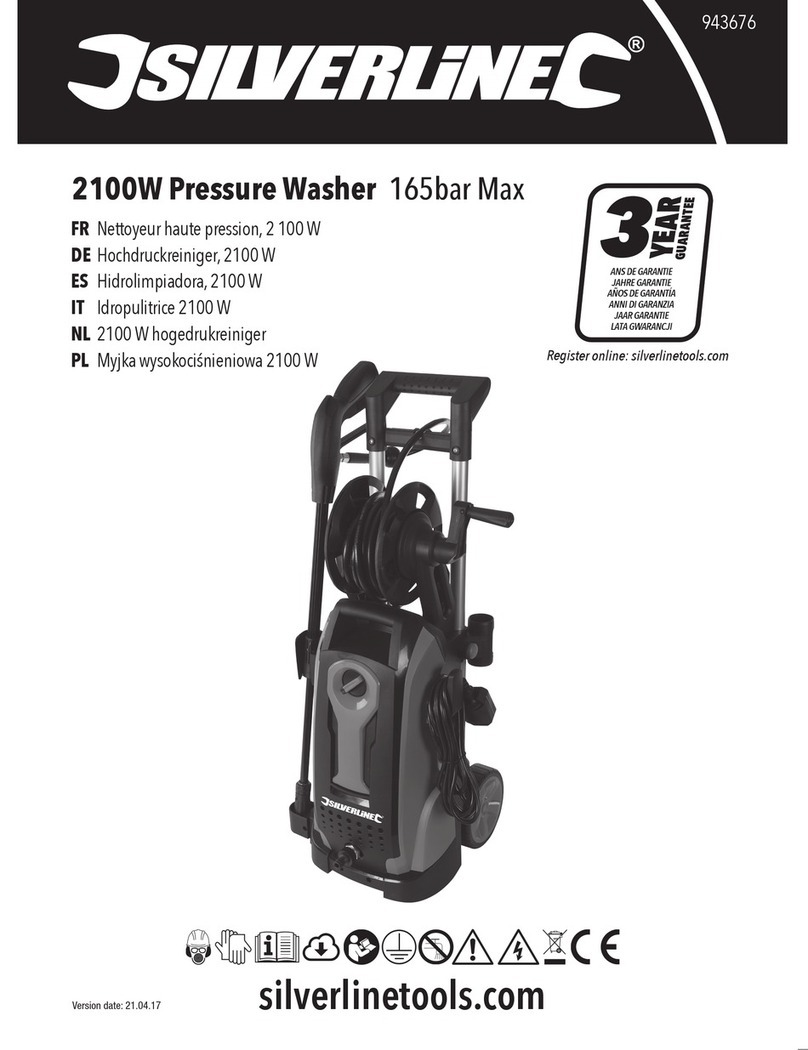
Silverline
Silverline 943676 User manual
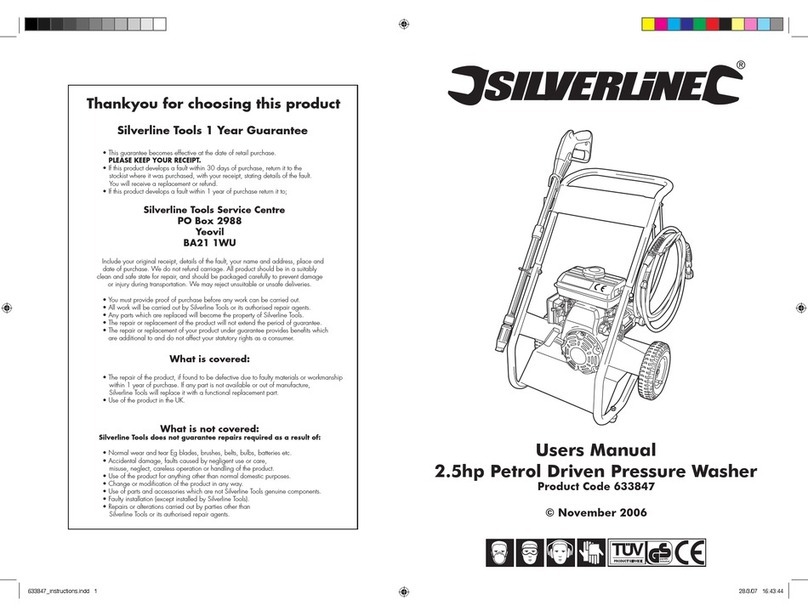
Silverline
Silverline 633847 User manual

Silverline
Silverline 389431 User manual
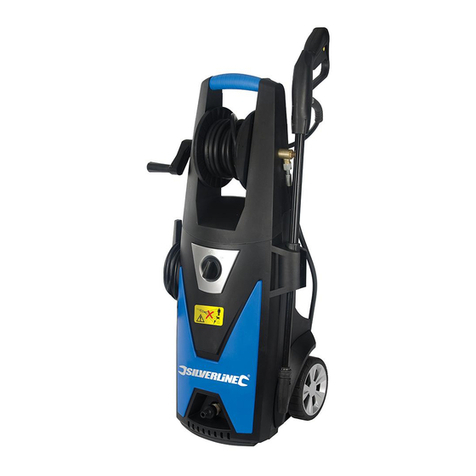
Silverline
Silverline 102377 User manual

Silverline
Silverline 1400W Pressure Washer User manual

Silverline
Silverline 633847 User manual
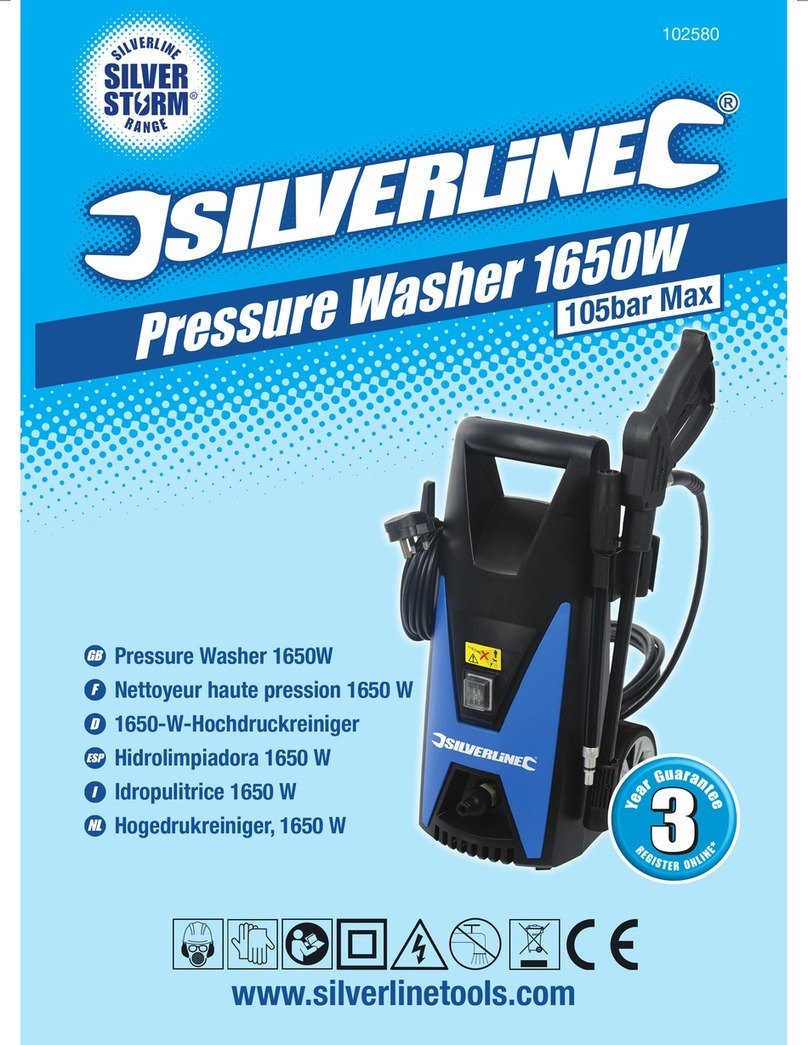
Silverline
Silverline 102580 User manual
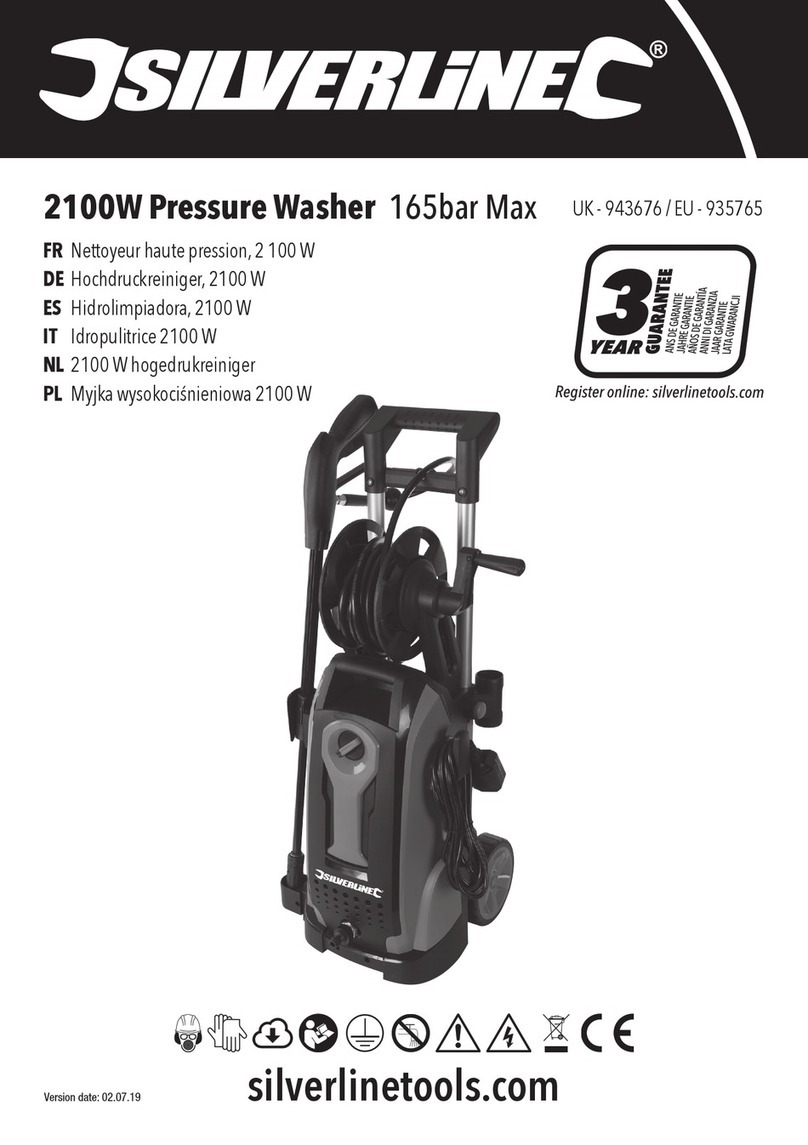
Silverline
Silverline 935765 User manual
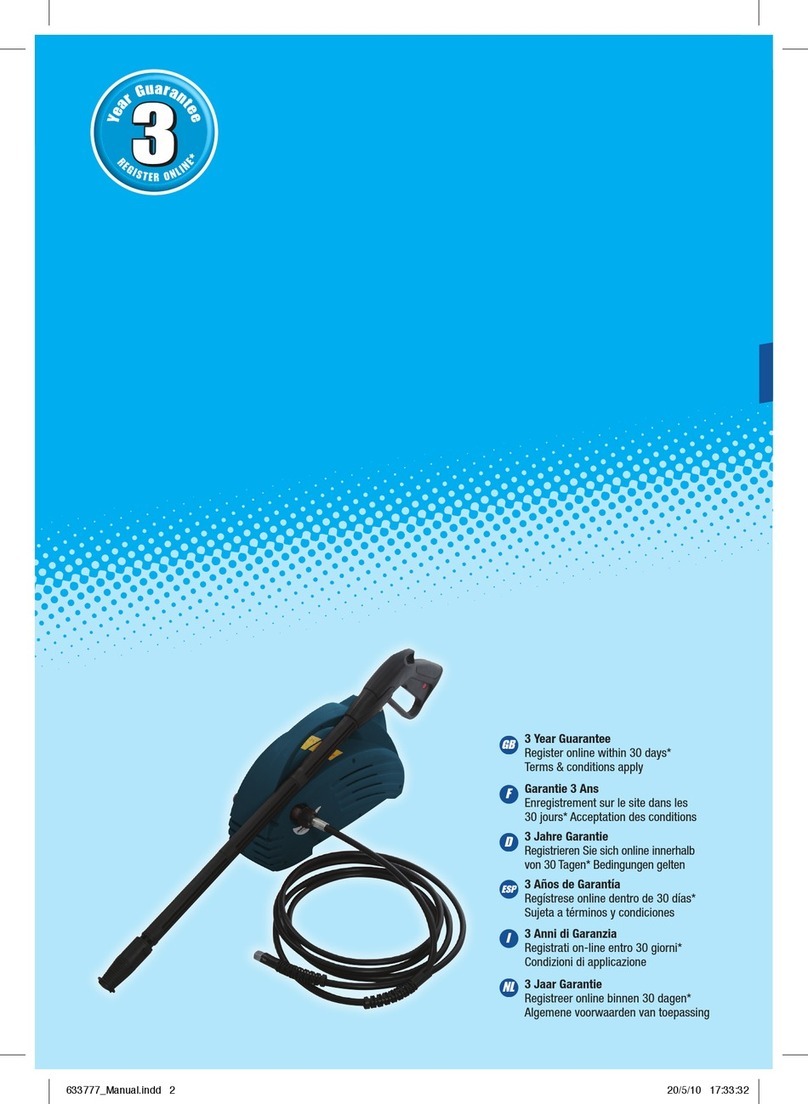
Silverline
Silverline POWER 633777 User manual

